Unique 316L stainless steel tube railings for beautiful boat design


Pulpits, pushpits and biminis: expert marine rail fabrication for luxury yachts and motorboats
Modern boat railings must withstand the uncompromising ocean environment, but they also have to look good. That’s why leading marine specifiers and architects have used our shaped stainless steel tubing in their designs for over three decades.
Our shaped steel tubes are durable and attractive in equal measure. From stunning staircases on superyachts to grab rails on speedboats, our shaped tubes and boat railings are second to none. They offer the marine industry aesthetic, structural and ergonomic advantages over standard round tubing and add the perfect finishing touch to any cutting-edge vessel.
Maximum resistance to corrosion
We make most of our exterior tubing for boat railings from stainless steel 316L (1.4404), which contains a higher nickel and molybdenum content for more corrosive resistance (we can work with duplex and superduplex stainless steel if required). We can also form from aluminium if required.

Luxury tenders and ribs
Timeless fabricate handrails and grab rails for some of the industry’s most prestigious and most discerning tender designers. The build quality and finish of all onboard features needs to exude the same level of luxury as those on super yachts. As with all our marine architecture, the ergonomics of the boat railings is paramount — especially as these boat railings serve an important role in keeping passengers safe and comfortable. We typically shape grab rails from our oval tubing and radius square tubing — hands fit comfortably and securely around these shapes (and unlike round tube, hands are not prone to the same degree of slippage). Robust yet refined, the boat railings are designed so that they are sturdy but with a slim projection so that they do not protrude too much. We fabricate bespoke boat railings for the front of the navigator’s seat, on the gunwales and to ease boarding and disembarking. We can also create boarding ladders. Please talk to us about our bending and finishing boat railing services.
Popular tubing for marine use
Oval tubes are our most popular tubing for marine use and are predominantly used for onboard boat railings such as pulpit rails, guard rails, grab rails and transom gates. We form this elliptical tubing in more sizes than any other tube supplier worldwide, giving naval architects, boat manufacturers and owners a wide choice regarding railing specification. Our flat-sided oval tubing is favoured for its sleek lines. Flat oval tubes make for stunning pushpit rails at the aft of any yacht or motorboat. Flat-sided oval tubes made from aluminium can be good grab rails on racing boats or when used to make lightweight bimini frames. Oval tubing and flat-sided oval tubing add luxury to any vessel - it looks sophisticated and feels better to grip than round tube railings. Our twisted oval tube makes for stunning spindles on internal staircases. The attractive contours catch the ocean light beautifully, and add an extra touch of class and elegance. For all our oval and flat-sided tubing, Timeless offers a bespoke tube bending service. We can create compound curves (curves that require two bends), sweeping curves, or tight radius bends. Speak to us about the radius that we can achieve, as well as our other fabrication services .

Customisation made easy
Whether it’s a refit, refurbishment, prototype or brand-new boat, our uniquely shaped tubing is a simple way to offer your clients greater choice with their yacht design. Our engineers will work hard to fabricate tubing of any size to meet your needs – even if this requires us to make new tooling. Many of our marine clients select stainless steel 316L tubing with a mirror polish. The highly reflective, smooth finish is achieved by polishing the tubing down to approximately 0.2 microns; the sleek and shiny surface reduces areas for corrosive elements such as sodium chloride to rest and cause damage. We can also form tubing from bronze or brass, or create a brass effect by applying PVD (Physical Vapour Deposition) titanium ore plating. If you like traditional teak wood but want it to have the strength and durability of aluminium or stainless steel, we can even apply a powder coat with a wood effect.
Refits and refurbishments for motorboats and yachts
If you want to rejuvenate your boat by replacing your railings with a customised profile, speak to us and we will be delighted to provide samples of what we can offer. For refits, we make stainless steel oval boat deck handrail and handles in a wide range of sizes and shapes (we can also source round stainless steel tubing if you want to replace your existing round railings with similar tube). Our experienced team of fabricators are specialists in welding stainless steel railings for yachts, motorboats and tenders. We can also polish boat parts such as ladders, gates, handrails, cleats, bollards, biminis and anchors. Our comprehensive stainless steel polishing service includes scratch removal and re-graining. You might own an older boat that has handrails that you want to rejuvenate. We can give the metalwork a super mirror polish to bring the boat back to its former brightness. Our metal fabricators are trusted by several leading British and international boat-makers, who use Timeless to bend, weld and polish the tube railings once we have shaped them. These naval architects and designers can rely on the fact that our specialist team always achieve high-quality bends and exceptional finishes. Outsourcing these fabrication services to our team creates efficiency and cost-savings in this manufacture process.

Ideally situated near the U.K's biggest marinas
Based in Poole on the south coast of England, Timeless Tube is close to several marinas in the areas of Poole, Christchurch and Southampton. Although we typically restore boat deck railings in our workshop, if necessary, our specialist team can weld or polish onsite for motorboats, yachts and tenders moored in the south of England.

Custom-made hinges for concealed gates and collapsible mechanisms
Timeless partner with internationally renowned hinge experts PE Marine Designz, who specialise in designing and making patented multi-pivot hinges for super yachts and motorboats. These bespoke hinge designs integrate clever functionality such as concealed power assistance with Timeless Tube’s premium shaped tube profiles to achieve both impressive aesthetics and performance. Combining high-end aesthetics and optimal functionality, the bespoke tube-based solutions remove the need for unsightly latches and unnecessary shrouding sometimes used to mask fittings. The unique designs are bespoke, so if you are looking for cleverly concealed gates and foldaway furniture and T-tops that do not compromise on style, speak to our team about these innovative geometric solutions, or find out more about PE Marine Designz’s pioneering tube technology and the solutions it provides for marine applications.
Marine related applications
- Balustrades
- Furniture (foldaway and freestanding)
- Boarding ladders

Tubing used in marine applications

An ergonomic, tactile shape that is perfect for handrails and balustrades in conjunction with structural glass and brickwork. A low-maintenance design commonly used for architectural and marine purposes.

Flat-sided Oval Tube
Clean, rounded lines and a flat-sided profile provide strength for architectural purposes – with a flat side useful for fixing to other elements.

D-shaped Tube
With a smooth top, flat section and incredible lateral strength, this ingenious design prevents water ingress and it’s easy to install. Ideal for handrail in public buildings and on marine craft.

Radiused Square Tube
Blended radius corners and a slight convex side provide greater strength than standard round tubing. This great alternative to box section tubing is popularly used for baluster railings and furniture.

Twisted Square Tube
Aesthetically striking, with the power to make a significant impact. Provides impressive strength integrity while being lighter and more cost-effective than conventional solid twisted bars.

Twisted Oval Tube
Innovative spiral forming applied to a classic oval tube design. This stunning twisted tube profile creates a mesmeric effect that is ideal for decorative metal architecture on buildings and boats.
Tubing solutions for niche marine applications
Our marine tubing goes beyond railings and staircases. For example, our engineers have worked closely with the team at premier marine equipment supplier, Lewmar, to create stainless steel tubing for an innovative mechanical awning for yachts. We’ve fabricated telescopic tubing for a hydraulic lift that is used to launch tenders and RIBS on super yachts. We have even made a door handle for a fridge on-board a yacht, with a special locking mechanism to prevent it from opening during voyages. Our engineers love using their creativity and expertise to produce tubing for new applications, so please chat to us to see if we can help with your projects.

Contact us for expert advice, quotes and free samples.
We can develop new sizes.
Don't see a size you need? Just specify the size you require in your message.
Contact details
By clicking 'Submit' you are consenting to us replying, and storing your details. (see our Privacy Policy )
Need help finding the right tube?
Talk to a specialist and find the right tube for your project.
Discover our product range
View our unique shaped metal tube profiles and joining systems.

Yachts Stanchion Gates.
Yachts stanchion gates. guardrail wire bracing leg, allowing an opening for a gate. giving side access. in the opening using guardrail wire and pelican hook, 610cb yachts guardrail stanchion gate., 610cb yachts guardrail stanchion gate. with cross member. 610mm over all height. 25mm ø tube mirror polished 316 stainless. width: legs centre to centre is 300mm. top eye: centre of eye height is 602mm. side loop thickness 5.9mm. centre eye: centre of eye is 310mm to base. can fit into any 25mm bases., 740cb yachts guardrail stanchion gate., 740cb yachts guardrail stanchion gate. with cross member. 740mm over all height. 25mm ø tube mirror polished 316 stainless. width: legs centre to centre is 300mm. top eye: centre of eye height is 732mm. side loop thickness 4.9mm. centre eye: centre of eye is 440mm to base. can fit into any 25mm base., 620h yachts guardrail stanchion gate., 620h yachts guardrail stanchion gate. 620mm over all height. 25mm ø tube mirror polished 316 stainless. width: legs centre to centre is 280mm. top eye: centre of eye height is 610mm. side loop thickness 4.90mm. centre eye: centre of eye is 300mm to base. can fit into any 25mm bases., 610n yachts guardrail stanchion gate., 610n yachts guardrail stanchion gate. 620mm over all height. 25mm ø tube mirror polished 316 stainless. width: legs centre to centre is 280mm. top eye: centre of eye height is 610mm. centre eye: centre of eye is 305mm to base. side loop thickness 4.95mm. to be used with stanchion bases 4117325 or 4117326, 610cbn yachts guardrail stanchion gate., 610cbn yachts guardrail stanchion gate. with cross member. 622mm over all height. 25mm ø tube mirror polished 316 stainless. top eye: centre of eye height is 610mm. centre eye: centre of eye is 304mm to base. side loop thickness 4.95mm. to be used with stanchion bases 4117325 or 4117326, where to find us.
Sea Screw Ltd. 4 Churchdale Road Eastbourne East Sussex England BN22 8PS
- Help & History
- Delivery Costs
- Conversion Chart
- Abbreviations Used
- Product Enquiries
- Sale Enquiries
- Terms, Conditions & Refund Policy
©2024 Sea Screw LTD.
- {{>productsMenu}} Products
- {{>trendsMenu}} News & Trends
- Equipment >
- Deck fittings, Boat care >
Boat stanchions, arches and guardrails
- What’s new?
Manufacturers
- ARC Marine (3)
- assea (4)
- Atkins & Hoyle Ltd. (1)
- Atlantic Towers (6)
- Atlantis Italia (3)
- ATN (2)
- Attwood (1)
- Beachcomber Fiberglass Technology (2)
- Beekmans RVS (1)
- Bimini Top Nautica (3)
- Blue Performance (3)
- Blue wave rigging hardware (1)
- BSI A/S (1)
- C-QUIP (1)
- Canepa & Campi (1)
- CARBON EQUIPMENT ltd (1)
- Carbonautica (2)
- CEREDI (2)
- Detmar (2)
- Directeck (2)
- Eval (3)
- Exit Carbon (3)
- Fishmaster (1)
- FJORDSTAR, LTD (1)
- Foresti & Suardi (6)
- Garelli (1)
- Gemini Marine Products (6)
- Goiot Systems (4)
- Harken (1)
- I-Carbon (3)
- INOX MARINE INNOVATION (22)
- LalucenteInox (1)
- Lenhardt & Wagner (1)
- Liros (1)
- Mar Quipt (1)
- Marine Accessories B.V. (2)
- Marinetech Edelstahlhandel GmbH & Co.KG (7)
- Mate USA Llc - Deerfield Beach FL USA (11)
- MAVIMARE (2)
- Mazzer Srl (2)
- Metalstyle Srl (2)
- MPI-INOX (2)
- nauticalcreations llc (1)
- Nautinox (26)
- NAVISHELL (1)
- NENUPHAR (1)
- Nettuno Marine Equipment (8)
- NODUS FACTORY (3)
- NorSap AS (1)
- Ocean s.r.l. (1)
- OCEANSOUTH (1)
- Olcese Ricci (1)
- Opacmare (1)
- Orange Marine (1)
- Osculati (3)
- Qingdao Allshine Marine Accessories Co,.Ltd (2)
- Qingdao K-Wing Industry Co., Ltd (1)
- Razeto & Casareto (6)
- Roca Industry (1)
- Samar (1)
- Schaefer (1)
- Seasmart (4)
- Seldén Mast AB (2)
- Solimar (1)
- Spinlock (2)
- Suncor Stainless (2)
- SWISS CARBON Marine Systems (2)
- Tallon Marine (1)
- TeakFlex (1)
- Tessilmare (14)
- Tietoset Marine Ltd. (2)
- TR INOX (21)
- Trend Marine Products (1)
- UltraGlozz Co. ApS (1)
- UMT MARINE LLC (1)
- USHIP (3)
- Velena Yacht (1)
- Versari & Delmonte (1)
- Wichard (1)
- WoodSpars (1)
- YCH Ind. Corp. (1)
- roll bars (51)
- arches (5)
- grab rails (49)
- staffs (23)
- grab rails supports (17)
- rub rails (17)
- scuba tank racks (13)
- rub rail ends (10)
- boat solar panel brackets (9)
- pulpits (8)
- stanchions (7)
- blocks (6)
- covers (6)
- lifeline terminals (6)
- stanchion sockets (6)
- tow bars (4)
- universal mounts (3)
- fairleads (3)
- lifeline backrests (3)
- nets (2)
- boarding poles (1)
Application domains
- for boats (52) for inflatable boats for pontoon boats
- for boats (37) for commercial fishing boats for open boats
- for yachts (23)
- friction (3)
- high-resistance (2)
- mast foot (1)
- vertical (1)
Working load
Breaking load, center diameter.
& reach your clients in one place, all year round
{{product.productLabel}} {{product.model}}
{{#each product.specData:i}} {{name}} : {{value}} {{#i!=(product.specData.length-1)}} {{/end}} {{/each}}
{{{product.idpText}}}

single block 7402
Working load : 227 kg Weight : 152 g
Harken® recommends equipping every system with Carbo lead blocks for safe furling from the cockpit. A 7402 ratchet maintains tension when spooling so the unit can furl smoothly and easily. Both the 7401 and 7402 have ball and socket bases ...
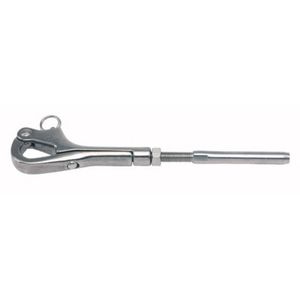
sailboat lifeline terminal 174-356
PELICAN HOOK WIRE ø4(LIFE LINE 174-356 Weight: 175.00 g Wire diameter: 4 mm
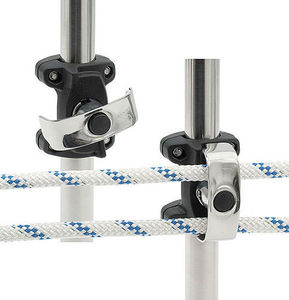
sailboat fairlead 480-501-01
FAIRLEAD DOUBLE, STANCHION ø25/30 Weight: 169.00 g Width: 58 mm Height: 72 mm

boat grab rail 2054-5
Streamlined with a molded, hinged, built-in fastener cover system, an Attwood exclusive. A unique, new Grab Handle that looks and works great on runabouts, fishing boats, jet boats, and RVs. Clean styling, shaped to fit your hand for ...

boat stanchion socket 15.480.26
This rod makes it possible to have a shower head on the stern gangplank. Made of black anodized aluminium + stainless steel parts. The shower head can be adjusted in any position. Lightweight and telescopic for easy storage, rod outer ...
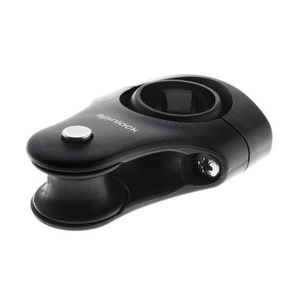
single block WL/2
Working load : 300 kg
Compact stanchion lead system Compact furling line guide system Reduces line friction during furling Fairlead model WL/1 straightline guide for intermediate stanchions Sheave model WL/2 for line entry and exit stanchions with unique ...

guardrail net 02040-0001
Item No. - 02040-0001 Default condition - SP (Reel) Diameter - 2.00 - mesh openings approx. 45 mm - netting width 60 cm - 50 m lengths Description Premium knotted safety netting of two mm white, braided Polyester with reinforced ...
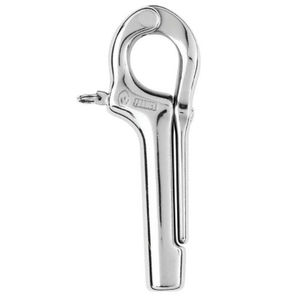
sailboat lifeline terminal 12837
An easy and effective way to close the lifelines gates The excentric shape and the length of the arm on the pelican hook allow the wires to be tensioned easily Tension: 28 mm Materials HR 17.4 PH stainless Steel grade Length (mm) ...

boat flag-staff FP03
Removable flag pole with internal locking device. Made of carbon fibre, clear matte finish; standard height 865 mm. Tubes with different lenght are made to order. It is easy and quick to deploy and remove. it his free to circular moving ...

boat flag-staff FP01X
Removable flag pole. Material : stainless steel Aisi 316L and carbon fiber. Removable and easy system with anti rotation quick lock. Once the rod has been removed, only the "female Smartlock" remains visible, which can be used via ...

boat stanchion ST30 - ST42
Removable stanchion with internal locking device. Made of carbon fibre, clear matte finish. Tubes with different lenght are made to order. It is used to protect stern / swimming platforms, yacht balconies and terraces. It is easy and ...
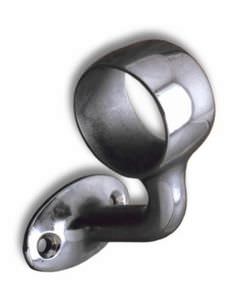
boat grab rail support 1279
Open: Ø 40 mm. Base: 62 x 33 mm. Center projection: 55 mm. Note: items are intended brass chrome plated unless otherwise specified.
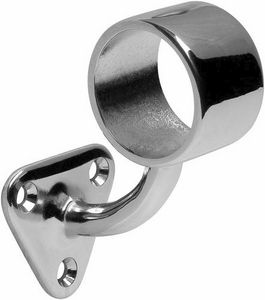
boat grab rail support 127902
Open: Ø 38 mm Base: 52 x 48 mm Center Projection: 50 mm Note: items are intended brass chrome plated unless otherwise specified.
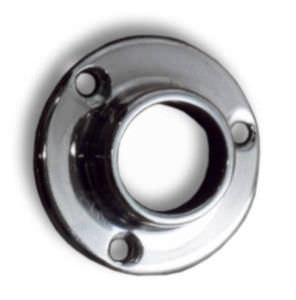
boat grab rail support 1305
Handrail: Ø 20 mm. Note: items are intended brass chrome plated unless otherwise specified.
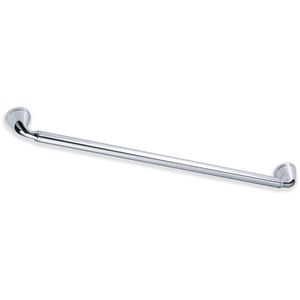
boat grab rail 377A.C
Brass handrail 377A600 x 48 mm 377B800 x 48 mm 377C1400 x 48 mm Brass handrail. Finish .L Polished .C Chromed Length 600 mm 800 mm 1400 mm

boat grab rail support 47B.C
Brass handrail fittings DimensionsØ 65 x H. 75 mm Finish .L Polished .C Chromed Hole diameter Ø 30 mm

pulpit universal mount 52B.C
Brass handrail fittings 52BØ 60 x H. 45 mm 142BØ 70 x H. 50 mm Bases for pulpit. Vertical 90°. Finish .L Polished .C Chromed Hole diameter Ø 22 mm Ø 25 mm
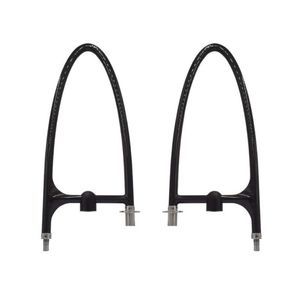
boat grab rail LEONARDO
Tall “swimming pool” style or standard size ladder grips, they can be left on deck or taken away with a few turns of a hand operated screw. They are available alone or they can be combined with Dalì or with your already existing ladder, ...
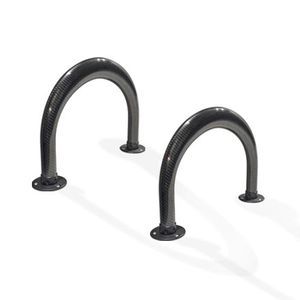
boat grab rail MIRO
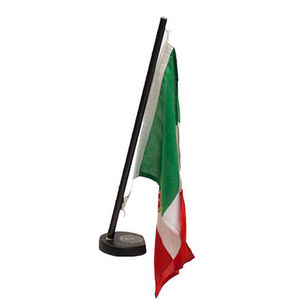
boat flagstaff ALISEO+
A whole new range of flagpoles is now available in carbon fibre. Highest technology construction and fantastic matte finishing with different sizes and diameters to perfectly match the stern or the deck of your yacht. The elegant Exit ...
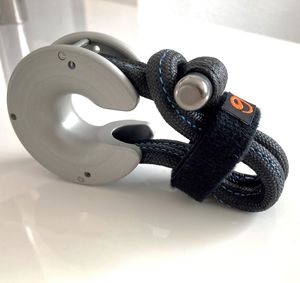
single block HK® single
Working load : 3,000 kg - 6,000 kg Breaking load : 6,000, 12,000, 8,500 kg Center diameter : 32, 22, 16 mm
HK16®, the Textile Hook® opening friction ring is the lightest and strongest sheet control solution on the market! This opening friction ring is easy to position on the rope and its double safety textile attachment system prevents ...
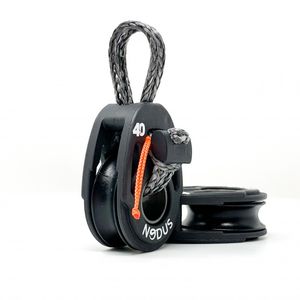
single block P Hi-Tech®
Working load : 200 kg - 350 kg Breaking load : 700, 500, 400 kg Center diameter : 8, 6, 5 mm
The Nodus Pulley is strong, safe, simple and efficient. Loads are driven directly from the sheaves to the attachment point, allowing for lightweight side plates. The link blocks share the same performance bearing system as the dynamic ...

sailboat fairlead Pad-Filoir®
Nodusfactory mast and deck wire The Nodus Factory bonding line is specifically designed to be mounted by bonding on a mast, a boom or on the deck for sheeting or furling line. + Use - Mast and deck fittings - Mast, boom, spinnaker ...

sailboat lifeline terminal 6949 / 695X

boat roll bar 1950
Boat arch for ribs and boats with a contemporary design made of mirror-polished AISI 316L stainless steel designed to fit virtually any boat with flat deck/fixing point area. Our boat a-frame Wing consists of 3 parts: 2 laterals and one ...
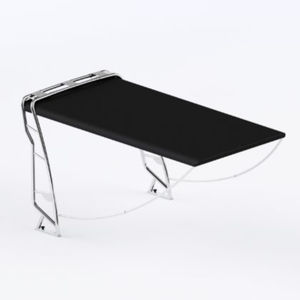
boat roll bar 1950T
Bimini arch for ribs and boats with an innovative and attractive design made of mirror-polished AISI 316L stainless steel, designed to fit virtually any boat with flat deck/fixing point area. Our boat a-frame WING consists of: 2 laterals ...

boat roll bar 1960
Boat arch for ribs and boats with an innovative and attractive design made of mirror-polished AISI 316L stainless steel designed to fit virtually any boat with flat deck/fixing point. EVO a-frame consists of 3 parts: 2 laterals and one ...

boat stanchion QUICK-LOCK
Our removable stanchion system is made of carbon fibre tube and AISI316L stainless steel fittings. We used the quick-mount devices for the deck base and the male plug. The stanchions are available in 3 sizes, with tube diameters 66 mm, ...

boat stanchion BAYONET LOCK
The removable bayonet-mount stanchion has a special deck socket to be mounted on the boat and a bayonet coupling device that engages with a 90° rotation. The stanchions are available in 2 sizes, with tube diameters of 45 mm or 66 mm. ...

boat flag-staff FP 3363
Our removable flag pole consists of 2 types: one with a screw connection and one with quick-lock connection. Both are made of carbon fibre tube and AISI316 stainless steel fittings. The screw-lock flag-pole has a threaded pin end, which ...

boat roll bar
Feito de aço inoxidável 316L diam 28, para garantir a estética do seu barco e não pesar muito. Nós podemos fabricar para todos os modelos de veleiros. a montagem é rápida e simples, o bastidor é entregue com os parafusos. Você também ...

boat roll bar Girofix
The arch founded on the Girofix allows you to lift a heavier annex, more than 80 Kgs. Consult us for the weight limit. Manufactured on demand in tube diam40, the arch will allow you to fix a multitude of things (the annex, the solar ...
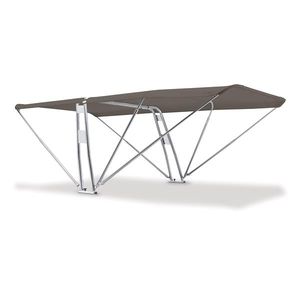
boat roll bar SUPERIOR
The Bimini Top SUPERIOR with boat roll bar included is handy and sturdy and thanks to its telescopic 316L stainless steel structure, it easy to be closed with spring buttons. Front and rear canvases are joint by stainless steel Norwegian ...
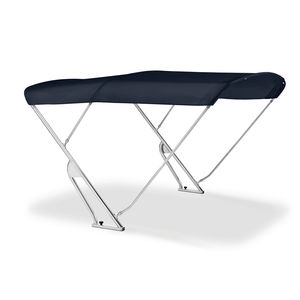
boat roll bar STRANGE
The STRANGE single tube roll bar with Bimini Top combines the advantages of a roll bar with the lightness of a Bimini Top. The base and the side plates give strength to the structure and the possibility of applying navigation lights ...
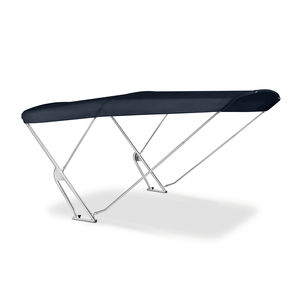
boat roll bar STRANGE XL
The STRANGE XL single tube roll bar with Bimini Top combines the advantages of a roll bar with the lightness of a Bimini Top. The base and the side plates give strength to the structure and the possibility of applying navigation lights ...

boat flagstaff tradition
WoodSpars™ was consulted by the shipowner for repair work on the lower masts. After thoroughly probing the spars, it was clear that whatever repairs were undertaken to the “rotten” areas, they would not guarantee the fractional rigging ...
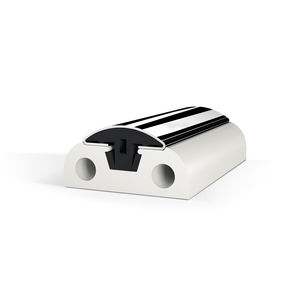
boat rub rail BINOX
BINOX is the first Stainless Steel 316 L Rub Rail without screws. The BINOX Rub Rail is set to revolutionize the Rub Rail industry around the world. BINOX is fitted without the use of unsightly screws and attachments. There are ...

boat rub rail end BINOX Joint Cap
TOP AND END CAPS Well-designed and functional top caps successfully cover the gaps at joints and keep the bars perfectly aligned and avoid the two-screw unaesthetic look. Elegant stainless steel end caps give the boat the finishing touch.

boat rub rail end BINOX
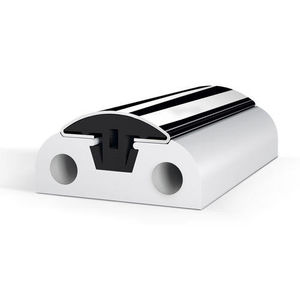
The first Stainless Steel fender profile WITHOUT SCREWS. Binox is the latest creation by Tessilmare and it was specifically developed for Mega Yachts. The innovative process in the construction of Binox RubRail allows a pressure ...

The elegant Stainless Steel joint caps keep the bars perfectly aligned, therby allowing a better technical and aesthetic effect. Joint caps are available for all Binox sizes.

The elegant Stainless Steel end caps provide the finishing touch for a streamlined finish. End caps are available for all Binox sizes.
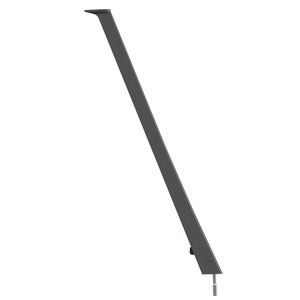
boat flagstaff AF
AF.2 is a removable FLAG POLE of a max lenght of 2,5m. Construction is carbon//epoxy, with carbon pre-preg technology, consolidated in autoclave and cured at high temperature (>90°C). Finishing is shiny C-LOOK with UV protection ...

boat roll bar NIGHT
UV / FIRE fabric 100% high tenacity and quality acrylic for maximum resistance to atmospheric agents. Structure of the Roll bar and arches in polished AISI 316 stainless steel. Roll Bar Ø 40 mm - Arch tube Ø 22. X 1.2 mm Standard: fixing ...
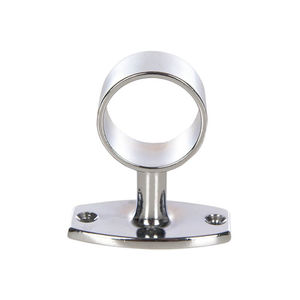
boat grab rail support 3194 series
Chrome plated brass or polished brass handrail central bracket.

yacht flag holder SL
CUSTOM SIZE SUPERYACHT FLAGPOLE - Sizes from 1200mm-2500mm - Carbon structure - Deckmounting, Snaplock - Colour on customers preference - Toplight on request
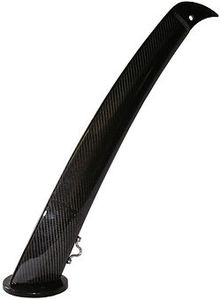
yacht flag holder S
- Sizes from 500mm-1200mm - Carbon structure - Deckmounting, Snaplock - Colour on customers preference - Toplight on request

scuba tank rack 01.88 series
made from polished stainless steel AISI 316L CODE - TUBE - PLACES - WIDTH - HEIGHT - LENGTH - PRICE 01.883 - Ø 40 mm - 6 - 330 mm - 700 mm - 650 mm - 400,00 € 01.884 - Ø 40 mm - 8 - 330 mm ...

scuba tank rack 01.89 series
made from polished stainless steel AISI 316L CODE - TUB PLACES - WIDTH - HEIGHT - LENGTH - PRICE 01.892 - Ø 25 mm - 4 - 480 mm - 484 mm - 580 mm - 265,00 € 01.893 - Ø 25 mm - 6 - 480 mm - 484 mm - 780 ...
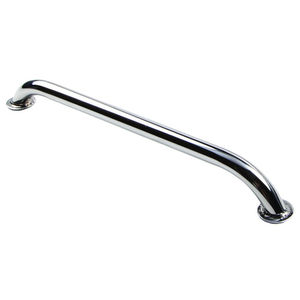
boat grab rail 01.41 series
made from polished stainless steel AISI 316L CODE - TUBE - A - B - C - D - PRICE 01.410 - Ø 22 mm - 350 mm - 60 mm - 310 mm - Ø 8 mm - 60,00 € 01.412 - Ø 22 mm - 500 mm - 60 mm - 460 mm ...
Your suggestions for improvement:
Please specify:
Help us improve:
Receive regular updates on this section.
Please refer to our Privacy Policy for details on how NauticExpo processes your personal data.
- Boat roll bars
- Boat grab rails
- Stainless steel grab rails
- Grab rails supports
- Boat rub rails
- Yacht rub rails
- Razeto & Casareto grab rails supports
- Manufacturer account
- Buyer account
- Our services
- Newsletter subscription
- AboutVirtualExpo Group
Yachting Monthly
- Digital edition

How safe are your guardrails?
- Stef Bottinelli
- March 3, 2016
Check them with these handy tips from the UK’s leading yacht refit experts

Imagine a pitching foredeck at night with nothing to prevent you sliding off the deck. Guardrails and stanchions can save your life, so it’s essential to make sure they are in good condition.
Ian Nicholson’s industry reference, The Boat Data Book , gives good advice: for a yacht up to 12m LOA, use wires of at least 4mm diameter in 316 grade stainless steel, 1×19 construction and a maximum stanchion spacing of 2.2m. Industry standard stanchion height (for boats up to 15m LOA) is 610mm, but some serious cruisers have stanchions of 800 to 900 mm. In addition:
Guardwires should not be PVC-coated. The wires should be visible and need end fittings and tensioning methods at least as strong as the breaking load of the wire. Adjustment arrangements can include simple lashings, turnbuckles or integrated, adjustable forks.
Lashings must be replaced regularly . UV degradation weakens them over time. Turnbuckles and other adjusters should be regularly checked. Guardwires should be tight enough so they do not sag between stanchions, but not so tight to cause wear spots as they pass through the stanchions.
Terminals should be secured fore and aft with clevis pins and split pins , which should be fully opened and either taped over or covered with a bead of silicone sealant to prevent them catching on sheets and sails. Split rings should not be used as they open too easily.
Wires should be regularly checked. If damaged, they must be replaced. Stanchions should be securely fastened to the deck and if bent or damaged, they should be repaired or replaced.

Berthon are safety experts. For more on this important aspect, go to: www.Berthon.co.uk/safety
Bavaria Yacht Info

- Bavaria Yacht Info »
- Member Forums »
- Bavaria Yacht Help! »
- Guard rail gates.
Author Topic: Guard rail gates. (Read 4517 times)
- Karma: +0/-0
- Posts: 1106
- Boat Model: Bavaria 33
- Boat Year: 2015
Re: Guard rail gates.
- Boat Model: Bavaria 34
- Boat Year: 2000
- Administrator
- Posts: 1515
- Karma: +18/-2
- Boat Model: 40 Ocean
- Boat Year: 2001
I added these gates to my Bav 34, i purchased the gates from Marine Maga store (in UK) back in 2015, they were £42each. I bought a couple of bases from Clipper and as I had to toe rail off to re-bed and reseal the stanchion bases I modified the bases so they didn't bend so easily and interlocked better on the toe rail. Its a easy job apart from needing two people and trying to access the stanchion bolts in each of the cupboards, but the is a removal piece of wood strip in the top of each cupboard.
- Second Mate
- Boat Model: B37
- Boat Year: 2006
Re: Guard rail gates. Bav37 2006 cruiser
- Posts: 1216
- Karma: +3/-1
- Boat Model: Bavaria 36
- Boat Year: 2002
Hi folks ... read with interest your comments re.guard rail gates. . . Have already agreed they must be next the shrouds for obvious reasons already discussed. My problem so far is I cannot find gates the height I need 24in / 35cm same as stanchions ??any comment.? . Kind regards Jackho
Hi folks ... read with interest your comments re.guard rail gates. A combination of the ageing process and needing hip surgery necessities me fitting these to my boat. If I’m going to sail again this coming season I must have these fitted. Any further advice peculiar to the 37 will be appreciated. Have already agreed they must be next the shrouds for obvious reasons already discussed. My problem so far is I cannot find gates the height I need 24in / 35cm same as stanchions ??any comment.? Also where can the base be sourced - same as existing . I also would like advice regarding fixing the bases etc. Are they screwed or bolted onto deck? All advic welcomed . Kind regards Jackho
My problem so far is I cannot find gates the height I need 24in / 35cm same as stanchions
Re: Guard rail wire size.
- Karma: +10/-0
- Boat Model: Cruiser 46
- Boat Year: 2005
- Able Seaman
- Boat Model: Bavaria 38
- SMF 2.0.19 | SMF © 2017 , Simple Machines

- Search forums
- Practical Boat Owner's Reader to Reader
Gate making with guard rail,
- Thread starter Binman
- Start date 20 Aug 2015
- 20 Aug 2015
I've decided to make a gate in the centre of my boat, I have one guard rail, I find it easier at this location and can get a good hand grip on the coach roof hand rail, also I don't want to disturb my dodgers every time. I intend buying a complete new guard rail wire for this, which will be made up to end both sides of the gap between the stansions, where the gate will be, now how do I form the gate between the stansions, I want to maintain the tension, with out having to slacken that bit of wire off each time the gate is used?
Sandy Bottom
Active member.
Google 'Pelican Hook' and you can use one of these to tension / release the bridging wire. Ideally the two stanchions either side of the gate will need a bracing stanchion at say 30 - 45 degrees to the gate stanchion i.e. The aft one will have a brace going backwards towards the stern and vice-versa. (If I have understood you correctly).

Deleted member 36384
drumbeat said: [/URL][/IMG] Click to expand...
Drumbeat's is the same as my Rival 41C. You need of course two stanchions about 2' apart, diagonal braces from a point about 2" below the top running 60 degrees down to the deck, obviously on the outside of the opening and in line with the guardrail wire. Consider the guardrail wire that will run aft from the gate (the one running forward will be the same). The wire should have a swaged on bottle screw threaded part. The holes in the stanchions should be bigger than the bottle screw swage. The other end of the wire should be an eyelet (mine are swaged threads, short length with a rectangular eyelet screwed on. Feed the bottle screw end through to the stern until the eyelet butts against teh stanchion hole. The aft end is of a length that allows a bottle screw to make up and tension the line. Repeat for the forward guard rail line. The gate is a short line, bottle screw one end, pelican hook other end. This arrangement allows guard rail wires to be sufficiently taught at all times even when the gate is open and the pelican hooks allow the gates to be taught when closed without always having to make adjustments. I have just bought 2m of stainless tube, 1" OD x 1.5mm thick for £7 off eBay to replace a bent stanchion, so cheap as chips. Nylon can be used to make bushings in the drilled holes so the wires don't rub wire on wire. Hope my explanation is clear.
BlowingOldBoots said: What a beautiful yacht and I assume this is Drumbeat's Drumbeat. Click to expand...
- 21 Aug 2015
Binman said: I've decided to make a gate in the centre of my boat, I have one guard rail, I find it easier at this location and can get a good hand grip on the coach roof hand rail, also I don't want to disturb my dodgers every time. I intend buying a complete new guard rail wire for this, which will be made up to end both sides of the gap between the stansions, where the gate will be, now how do I form the gate between the stansions, I want to maintain the tension, with out having to slacken that bit of wire off each time the gate is used? Click to expand...
PuffTheMagicDragon
GrahamM376 said: View attachment 53206 Click to expand...
PuffTheMagicDragon said: Good idea that I shall probably copy. Is that a Wichard fitting? Is there a special name for it, please? Thanks! Click to expand...
Well-known member
GrahamM376 said: My solution was to cut the guardwire adjacent to 2 stancheons and swage fittings as seen in photos below. Some tension still kept in the rest of the wire and no need to brace stancheons, 12 years this way hasn't bent anything, just make sure boarders grab the shrouds. Click to expand...
GrahamM376 said: My solution was to cut the guardwire adjacent to 2 stancheons and swage fittings as seen in photos below. Some tension still kept in the rest of the wire and no need to brace stancheons, 12 years this way hasn't bent anything, just make sure boarders grab the shrouds. View attachment 53207 View attachment 53206 Click to expand...
birdseye said: Can you still hang fenders off your guard rails if you dont brace? Click to expand...
drumbeat said: My phrase was " Ideally the two stanchions either side of the gate will need a bracing stanchion......." Your photo shows an aluminium toerail (I think?) with through bolting - very different from a deck fastened stanchion. I don't know what the OP has as he doesn't say, so maybe he needs to brace or maybe he doesn't -but from the info given I cannot say that he doesn't need braces. I also cannot "just make sure boarders use the shrouds" as you do - because there is about a 6 feet gap between the shrouds and the gate! :encouragement: Click to expand...
Thank you all for your replies, the stanchions on my boat have good size plates about 4x3 inches, I have a narrow walk way, safe way for me is to hang on to the wooden grab rail. Grabbing the stays out the question, when I try that I feel I'm leaning backwards, I board my boat as follows, from the centre board on my dingy, I step up keeping my feet and legs on the outside of the guard rail lean over and grab, grab rail then step over guard rail, reverse getting off, if the gate was in the cockpit there is nothing to grab hold of, plus a big step down onto the fuel locker.
- 22 Aug 2015
drumbeat said: It is not the policy of Her Majesty's Government to either confirm or deny ...... Click to expand...
Graham, my stanchions bases are bolted through the deck, with plates on underside.
Binman said: Graham, my stanchions bases are bolted through the deck, with plates on underside. Click to expand...
- 23 Aug 2015
Just done this; Used S3i for the pelican hooks as MUCH cheaper than a well known ropeshop. Stanchions already had the braces, so only cutting the wire and getting the local place to roll swage the ends on. Pelican hook to shackle on a terminal, up against one stanchion. The other side of the gate had 'stopper' ferrules swaged to the wire with plastic covers up agains the other stanchion to maintain tension in the guard wire. And no, i didn't take a pic... Drumbeat is cold moulded? Very nice.
Graham, funny enough, I brought a set of steps the other day, rope with heavy duty plastic treads, think I will fit a cleat to secure them to. Was going to fit one both sides to assist with spring lines when mooring against our pontoon.
Other threads that may be of interest
- 11 Mar 2024
- East Coast Forum
Members online
- Wandering Star
- BarrytheViking
- langstonelayabout
- agroundagain
- Andrew_Trayfoot
- Chiara’s slave
- Suffolk Explorer
- WindermereColvic
- Charlie Boy
- PetiteFleur
- Teddingtown
- snowbird30ds
- Motor_Sailor
- Suffolk_Newbie
Share this page
You are using an outdated browser. Please upgrade your browser to improve your experience.

Force 4 Guardrail Set
- Get it on Thursday, 21st March if ordered within the next --:--:-- and select Next Day Delivery *UK Mainland Only
- This is a special order product and may experience shipping delays. Please call our Mail Order team to confirm delivery lead time.
Ask a question

- Description
- Availability
- Delivery & Returns
- Questions & Answers
A self-assembly and self-install guardrail set. Easy to use, you can create your own custom length guardrails by simply cutting the wire to length, stripping off 40mm of the white PVC cover at each end and attaching the quick connect terminals.
The fittings are AISI 316 stainless steel.
Set includes
- 10m of 4mm diameter 7x7 stainless steel wire rope (PVC covered, overall diameter 7mm)
- 2 quick attach terminals (1x left-handed, 1x right-handed)
- 2 threaded forks with nut and clevis pin (1x left-handed, 1x right-handed)
- 6 allen head grub screws and 1 allen key
A pair of extra end fittings is also available (Product Code: 851131) to make subsequent guardrails if required.
This item is currently not in stock but is available to preorder, with a lead time of up to 14 days.
Stock can move quickly, so this is just a suggestion of current levels, please phone the shop to confirm.
The ship to store service is based on Head Office sending stock to a branch.
If you wish to call & collect stock, please do so over the phone using the number provided.
- Good Availability
- Low Availability
- One item left
Royal Mail Service Update: Please be aware when choosing Royal Mail as your preferred delivery method, your delivery time may be impacted by ongoing strikes and may take up to 20 working days. If your order is time critical we suggest choosing a courier or Next Day Service
Our Mail Order team ship chandlery, yacht parts and sailing clothing around the world. We use the best value couriers available, and we will endeavour to get your products to you as quickly and as cost effectively as possible.
International Orders : Due to delays we have had to suspend our international delivery options.
UK Standard Delivery
- UK Mainland 0 - 2Kg (small jiffy) £3.95 Royal Mail Service. Despatch within 3- 5 working days, delivery in 7-10 working days for orders under £50.00
- UK Mainland up to 25Kg £5.95 Courier service with signature. Despatch within 3- 5 working days, delivery in 7-10 working days
- UK Mainland 25Kg+ Price on request
- UK Mainland Next Day 0 - 25Kg £9.95 Courier service with signature, orders must be placed before midday
- Northern Ireland, Highlands & Islands 0 - 2Kg (small jiffy) £3.95 Royal Mail Service. Despatch within 3- 5 working days, delivery in 5-7 working days for orders under £50.00
- Northern Ireland, Highlands & Islands 1 - 25Kg £10.95 Courier service with signature. Despatch within 3- 5 working days, delivery in 7-10 working days
- Northern Ireland, Highlands & Islands 25Kg+ Price on request
- Channel Islands 0 - 2Kg (small jiffy) £5.95 Royal Mail Service Despatch within 3- 5 working days, delivery in 5-7 working days for orders under £50.00
- Channel Islands 1 - 25Kg £13.50 Courier service with signature. Despatch within 3- 5 working days, delivery in 5-7 working days
- Channel Islands 25Kg+ Price on request
UK Exceptional Delivery
- UK Mainland; Antifoul & paints £5.95
- UK Mainland; Inflatable dinghy £10.00
- UK Mainland; Liferafts £17.50
- UK Mainland; Flares £49.95
- Northern Ireland, Highlands & Islands; Antifoul & paints £9.95
- Northern Ireland, Highlands & Islands; Inflatable dinghy price on request
- Northern Ireland, Highlands & Islands; Liferafts price on request
- Northern Ireland, Highlands & Islands; Flares not available to ship at this time
- Channel Islands; Antifoul & paints £13.50
- Channel Islands; Inflatable dinghy price on request Channel Islands; Flares not available to ship at this time
For further delivery information click here.
Standard Returns
If you are not entirely happy with your purchase, we will exchange or refund your goods in full, provided that the items are returned within 14 days of receipt.*
Please check the condition of goods on arrival - we are unable to accept goods damaged during shipping after 14 days.
Returned goods must be packaged securely, with all original packaging undamaged and in a saleable condition i.e. shoe boxes must be in the same condition as when received.
Goods must be unused and security seals intact.*
If you would like to return goods because they were ordered incorrectly or if clothing does not fit, return postage will be at your expense. If you would like us to replace the goods with another size or colour, we will charge carriage on the replacement.
Please be aware that some navigational and safety products may be dated, and as such a full refund may in some cases not be possible. If you are purchasing dated navigational charts we suggest you contact us for more information.
Faulty Goods
If you receive your goods and believe them to be faulty, please contact us straight away with a brief description of the problem. If we require you to return the product for a replacement, we will send you a pre-paid Royal Mail label for delivery back to us. Unfortuantely we cannot send the courier back to collect the items.
Returning goods to Force 4 is easy!
- Please contact us by ringing 0345 1300 710 or email on [email protected] . This way we'll be able to determine whether you would like to return the product for a refund or whether you'd like to exchange the product. We are unable to process the return of faulty goods that we're not expecting.
- We'll then give you a returns number. This returns number will need to be clearly marked on the outside of your parcel so it can be identified on arrival. Please note, failure to mark a returns reference number on the outside of your parcel may result in a delay in processing your return.
- Don't forget your proof of postage, just in case!
- Once we receive the item we'll be able to proceed with a refund or an exchange.
*this excludes faulty goods with manufacturers defects. If goods are found to be faulty during use, after the returns period, please just give us a ring on 0345 1300 710 and we'll be happy to help.
Hello, How are the ends secured on the wire? ken
They are secured by allen head grub screws.
Stock Alert
Please alert me via email when this product is back in stock.
Please read our privacy policy for more information about how we protect your personal data.
Men's Size Guide
- ALL MOSCOW TOURS
- Getting Russian Visa
- Top 10 Reasons To Go
- Things To Do In Moscow
- Sheremetyevo Airport
- Domodedovo Airport
- Vnukovo Airport
- Airports Transfer
- Layover in Moscow
- Best Moscow Hotels
- Best Moscow Hostels
- Art in Moscow
- Moscow Theatres
- Moscow Parks
- Free Attractions
- Walking Routes
- Sports in Moscow
- Shopping in Moscow
- The Moscow Metro
- Moscow Public Transport
- Taxi in Moscow
- Driving in Moscow
- Moscow Maps & Traffic
- Facts about Moscow – City Factsheet
- Expat Communities
- Groceries in Moscow
- Healthcare in Moscow
- Blogs about Moscow
- Flat Rentals
The Moscow Metro – MCC – MCD – everything about capital’s subway
Moscow Metro map and journey planner app called Yandex.Metro is available for iOS and Android for free.
We have a great Moscow Metro & Stalin Skyscrapers Private Tour across all famous metro stations, available for you every day.
1. Famous Moscow metro stations
Kievskaya (circle line).

The station was opened on March 14, 1954. It was named after the nearby Kievsky Railway Station. Decorating of station is devoted to friendship of Russian and Ukrainian people. Rich mosaic decoration is made from smalt and valuable stones by project of Ukrainian architects, chosen from seventy-three works presented on competition.
Kievskaya (Dark-blue line)

It was opened on April 5, 1953. Design of the station is devoted to the Soviet Ukraine and reunion of Ukraine and Russia. The station is decorated with a large number of the picturesque cloths executed in style of socialist realism in fresco technique. The fresco «Holiday in Kiev», made in 1953 was practically destroyed in 2010, due to an accident during nearby constructing works. While the fresco recovery, restorers revived its original appearance that had gone through many changes since its creation.
Ploshad Revolutsii

The station was opened on March 13, 1938. The most interesting feature of the station is 76 bronze figures, situated in niches of 18 arches. This peculiar gallery of images of Soviet people, aimed to personify force and power of the country, its glorious past and bright future. One of the bronze sculptures — a dog that accompanies a frontier guard — is believed to bring good luck if you touch its nose.
Prospekt Mira

Prospect Mira station of the Circle line was opened on January 30, 1952. It used to be called Botanical Garden up to June 20, 1966. The station’s decoration is devoted to development of agriculture in the USSR. Light marble and bas-reliefs by sculptor G. I. Motovilov decorate poles of the station. Famous smalt panel «Mothers of the World» by A. N. Kuznetsov is situated in the lobby.
Komsomolskaya

Komsomolskaya station was opened on January 30, 1952. The station has rich decoration devoted to a fight of USSR against overseas aggressors and victory in the Great Patriotic War. Mosaic panels from smalt and valuable stones, created according to sketches of the Lenin Award winner Pavel Corin, represent famous Russian commanders and weapons of different eras.
Novokuznetskaya

The station was opened on November 20, 1943. Its name was originally written through a hyphen: ‘Novo-Kuznetskaya’. The interior of the station is rich with decorating elements. The idea of creative force and power of Soviet people, its remarkable victories in the Great Patriotic War found realization in architectural design of station. The perimeter of the escalator arch is decorated with bronze sculptures by the sculptor N.V.Tomsky.
Novoslobodskaya

Novoslobodskaya station was opened on January 30, 1952. It was called after Novoslobodskaya street, where the station is situated. 32 original stained-glass windows from multi-colored glass, framed with steel and gilded brass and the famous mosaic panel «World peace», situated at the face wall the station, are made by sketches of Pavel Dmitriyevich Corin.
Dostoyevskaya

Dostoevskaya is comparatively new station, opened on June 19, 2010. It is situated at Suvorovskaya Square. Russian writer Fedor Dostoyevsky was born and lived in this district of Moscow. Therefore, the station bears his name and features scenes from his works «Crime and Punishment», «The Idiot», «Demons», «The Brothers Karamazov». Artist Ivan Nikolaev, the author of the decoration, said that depicting scenes of violence shows depth and tragedy of Dostoevsky’s work.
2. General information about Moscow metro
Metro working hours, navigation, wi-fi.
The Moscow Metro is open from about 5:30 am until 1:00 am. The precise opening time varies at different stations according to the arrival of the first train, but all stations simultaneously close their entrances and transitions to other lines at 01:00 am for maintenance. The minimum interval between trains is 90 seconds during the morning and evening rush hours. Each line is identified according to an alphanumeric index (usually consisting of a number), a name and a color. Voice announcements in Russian refer to the lines by name and by numbers in English. A male voice announces the next station when traveling towards the center of the city or the clockwise direction on the circle line, and a female voice – when going away from the center or the counter-clockwise direction at the circle. The lines are also assigned specific colors for maps and signs.
Free Wi-Fi is called MT_FREE and available on all 14 lines (inside the trains).
Using Metro services is frequently the fastest and the most efficient way to get from one part of the city to another. But during daytime Moscow Metro stations are usually overcrowded so if you want to just enjoy the beauty of the underground, it’s better to visit it late in the evening.
MCC and MCD
Since 2016 The Moscow Metro is connected to two new types of rail transport. The first one is MCC – Moscow Central Circle. It has 31 stations around the city with changes to metro stations (most of them require to walk a few minutes via the street). The second one is MCD, Moscow Central Diameters, a system of city train services on existing commuter rail lines in Moscow and Moscow Oblast. MCD has several lines, they’re being marked as D1, D2 etc. Changing to both MCC and MCD from the Metro is free when your journey is within the city. Both MCC and MCD lines exist on all of the Moscow Metro maps.
Interesting facts about Moscow metro
213 people were born in the metro during the World War II, when it was used as a bomb shelter.
There are 76 bronze sculptures of workers, peasants, soldiers, sailors, etc. at Ploshchad Revolyutsii station. There is legend connected with this station. To pass any examination successfully, a student should touch the bronze dog’s nose («the Frontier Guard with a Dog» sculpture). You can easily understand high popularity of this legend by looking at the polished nose of the dog.
It is said that some of the magnificent mosaics at several central stations, for example the «World Peace» mosaic at Novoslobodskaya, were made with the pieces of enamel and smalt, taken from the famous Christ the Savior Cathedral, before it’s destruction.
As any other dungeon the Moscow metro, has its own ghosts. The most famous one is the old lineman. He is not dangerous and usually hides into the wall, when people appear. The ghostly metro train is much more dangerous. It appears after midnight at the Circle Line and consists of old-time carriages. It sometimes stops at the stations and opens its doors, and then goes back into the darkness. It is said that the souls of Stalin’s prisoners, perished during the building of the metro are locked in the train forever.
3. Moscow Metro tickets
1 or 2 trips.
You can buy tickets in ticket offices or in automatic ticket machines. Passes for 1 or 2 trips are the most expensive. They sold only in ATM and cost 55 and 110 rubles (€0.55 and €1.10) respectively.
More than 2 trips
All the other kinds of tickets are available in the ticket offices. Tickets for bigger amount of trips are more profitable.
«90 Minutes» ticket
A ticket «90 minutes» is valid for one trip on the metro and an unlimited number of trips on surface transport within this time. It costs 65 rub (€0.65).

The «Troyka» card
You can also use «Troyka» – refillable card to pay for travelling on all kinds of public transport – metro, buses, trolley-buses, trams, monorail and blue minibuses. With «Troyka» one trip costs 35 rub (€0.35).

PLAN YOUR TRIP WITH US

Happy to help you with everything, from general plan of your visit to plane tickets or hotel stay. We may also support your Russian Visa request with a letter of invitation if you need so.
SEE OUR TOURS

We host around 60 tours every month in English, Russian, German, Italian, Spanish, Arabic and other languages. All of our tours =>
SAVE THIS LINK

If you only started to think about visiting Moscow, just save our site in your browser’s bookmarks or follow us on Facebook and Instagram to be in touch.
Tour Guide Jobs →
Every year we host more and more private tours in English, Russian and other languages for travelers from all over the world. They need best service, amazing stories and deep history knowledge. If you want to become our guide, please write us.
Contact Info
+7 495 166-72-69
119019 Moscow, Russia, Filippovskiy per. 7, 1
Mon - Sun 10.00 - 18.00
Please enter at least 3 characters
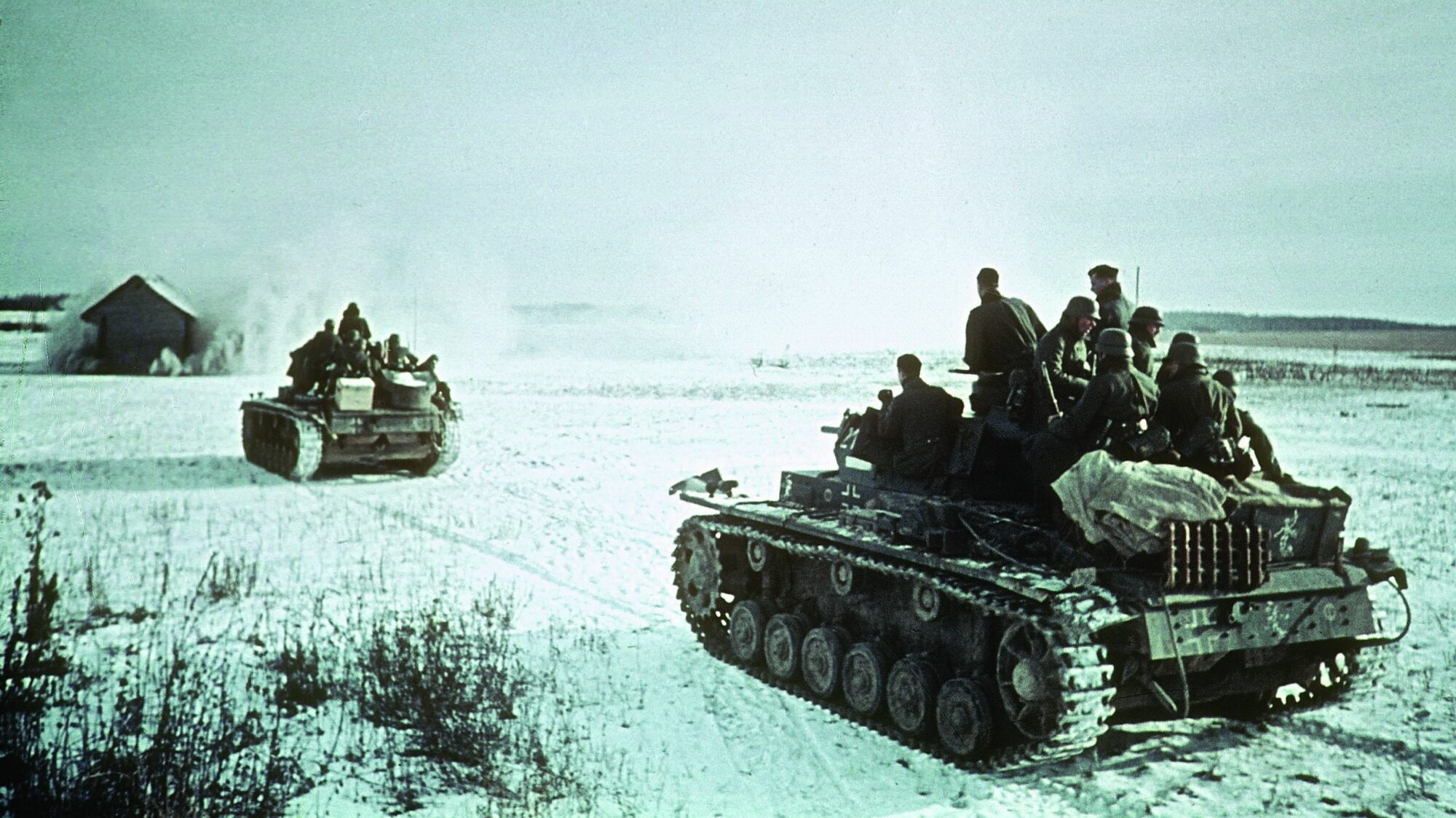
Panzers at the Gates of Moscow
Red Army forces mounted a gallant stand against the Germans during Operation Typhoon.
This article appears in: September 2009
By Jonathan Jordan
The war map gave Adolf Hitler every reason to be confident. Operation Barbarossa, Germany’s invasion of the Soviet Union begun on June 22, 1941, had succeeded spectacularly on nearly every front. One Soviet army after another had been smashed as Germany’s Ostheer, its army in the East, plunged deep into the industrial heart of Josef Stalin’s vast Eurasian state. By September, Hitler’s legions were within sight of Leningrad, while to the south German and Romanian divisions had swept across the north shores of the Black Sea, threatening vital petrochemical and agricultural production within the vulnerable Ukraine and Crimean regions.
Between the two sectors, Army Group Center, under Field Marshal Fedor von Bock, had taken 610,000 prisoners and destroyed 5,700 enemy tanks. Bock’s soldiers had conquered land as far eastward as the Russian city of Smolensk and were now less than 180 miles from the Soviet capital.
It was time, Hitler decreed, for a push against the center—toward Moscow.
“The Last, Great Decisive Battle of War”
Operation Typhoon, the campaign Hitler predicted would be “the last, great, decisive battle of the war,” was the result of a debate between Hitler and the army high command, Oberkommando des Heeres (OKH), over the war’s military objectives. From the beginning of Barbarossa, Hitler had insisted that the Wehrmacht give top priority to the destruction of Soviet field armies, and only afterward to the capture of strategic assets in the north and south. Prestige targets like Moscow did not figure prominently in Hitler’s planning, and as late as August 1941, his orders to OKH stressed that “the most important missions before the onset of winter are to seize the Crimea and the industrial and coal regions of the Don, deprive the Russians of the opportunity to obtain oil from the Caucasus and, in the north, to encircle Leningrad and link up with the Finns, rather than capture Moscow.”
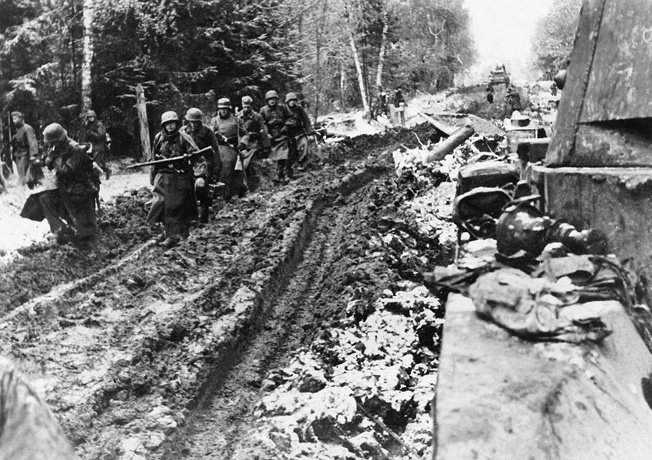
But August brought smashing German successes to the north and south of the Eastern Front, lending credence to intelligence reports that the Soviet regime teetered on the brink of collapse. Moreover, a tempting cluster of Soviet divisions seemed to be massing west of Moscow around the cities of Vyaz’ma and Bryansk, ripe for encirclement by Hitler’s fast- moving panzer spearheads.
Hitler thus allowed himself to be persuaded by OKH and his field generals to launch a major attack against forces defending the Soviet capital. On September 6, he issued Führer Directive 35, which called for the destruction of Soviet armies opposite Army Group Center, to be followed by the pursuit of Soviet forces along the Moscow axis.
Challenges of Logistics
To put Führer Directive 35 into operation, the staffs of Army Group Center and OKH prepared plans for Operation Taifun (Typhoon), a massive offensive along a 150-mile front employing 15 panzer divisions, eight motorized divisions, and 47 infantry divisions—a total of about 1.9 million men. For the attack, Army Group Center assembled 4,000 heavy artillery pieces, 549 combat aircraft, and as many as 1,700 tanks. For once, Hitler’s generals would enjoy numerical superiority over their Soviet opponents in addition to their well-known qualitative edge.

The plan called for a double envelopment of Soviet frontline forces at the rail hub of Vyaz’ma on the Smolensk-Moscow highway. Col. Gen. Hermann Hoth’s Third Panzer Army would surround Vyaz’ma from the north, while Col. Gen. Erich Hoepner’s Fourth Panzer Army would attack from the south. Farther south, Col. Gen. Heinz Guderian’s Second Panzer Army would encircle the defenders at the crossroads center of Bryansk. Once Vyaz’ma and Bryansk were encircled and their defenders wiped out, the Soviet capital would presumably be enveloped or overrun, as circumstances dictated. Guderian would strike out for Bryansk on September 30, and the main thrust would begin on October 2.
If the Ostheer had a weakness, it was its logistical tail. Captured rail lines were handling only around half to two-thirds of their former capacity, while competing demands by garrison commanders in Poland squeezed supplies passing through to the front. To make matters worse, Typhoon’s six armies had only four major railheads from which to draw ammunition, fuel, and food, and the armies could not operate far from these railheads, given poor road networks and Germany’s chronic shortage of motor transport. Two-thirds of Germany’s artillery was still horse-drawn as Operation Typhoon began. Of the 13,000 tons of supplies per day needed to sustain Army Group Center’s 70 divisions, its motor pool was able to supply just 6,500 tons over decrepit Russian roads.
The Soviet Army’s Woeful Position
If the situation looked daunting for the German planners, it was far worse for their Soviet counterparts. The grim task of defending Moscow fell primarily to the Western Front, or army group, commanded by Lt. Gen. Ivan Koniev. Koniev’s front consisted of six rifle (infantry) armies, a five-division cavalry group, and three reserve rifle divisions, and it was supported to the south by the three-army Bryansk Front under Lt. Gen. Andrei Yeremenko. These two fronts, plus a six-army reserve front under Marshal Semyon Budenny (which had two armies plugging gaps in the front line), had been engaged in piecemeal counterattacks at Stalin’s insistence since August and were considerably worn down, so that each Soviet army was, more or less, the equivalent of a German corps.
While the Western, Bryansk, and Reserve Fronts amassed 95 divisions with 864,000 combat troops, they labored under crippling disadvantages. All three were seriously short of heavy artillery, combat aircraft, and medium tanks. The average rifle division—composed largely of ill-trained recruits—was around 5,000 to 7,000 soldiers, less than half the authorized strength of around 14,000. To make matters worse, the deeper German columns drove into Soviet territory, the less Stalin tolerated a strategy of trading space for time, which limited his generals’ options.
Putting Pressure on the Capital
The battle for the Soviet capital opened on September 30, with a lightning attack by Guderian’s panzers, which struck northeast toward the transportation hub of Orel and due north toward Bryansk. Guderian’s veterans smashed five divisions and ripped open the southern flank of the Soviet Thirteenth Army. On October 3, his panzers rolled into Orel so rapidly they overtook trams clattering down Orel’s streets, and the Thirteenth Army fled toward Bryansk.
Typhoon’s main effort began on October 2, when the Third and Fourth Panzer Armies turned on the Soviet defenders around Vyaz’ma. Third Panzer, based in Smolensk, hit the juncture of Koniev’s Nineteenth and Thirtieth Armies, rupturing the two armies’ flanks. In two days, it captured bridges over the Dniepr River, opening the northern door to Vyaz’ma.
South of Vyaz’ma, Hoepner’s Fourth Panzer Army attacked on a narrow front and broke through Budenny’s Forty-third Army, holding its LVII Panzer Corps in reserve to exploit the breakthrough. On the way, it dismantled Budenny’s Thirty-third Army, a second-echelon formation, and by October 5 Hoepner had bored a hole in Soviet lines wide enough to throw LVII Panzer Corps into the enemy rear east of Vyaz’ma.
While Bock surged forward with his armored divisions, his three infantry armies (the Second, Fourth, and Ninth) succeeded in pinning the Soviet Sixteenth, Twentieth, Twenty-fourth, and Fiftieth Armies. Fierce pressure prevented those four defending armies from either retreating or coming to the aid of their hard-pressed comrades around Vyaz’ma and Bryansk.
One Million Men
At the time Typhoon was launched, the Kremlin was still preoccupied with its Ukrainian front; it took three irreplaceable days before Stavka, the Red Army high command, awoke to the threat posed by Army Group Center and summoned reserves from the Urals, Central Asia, and the Far East. To the north, General Koniev threw whatever reserves he could find into a futile counteroffensive to halt the Third Panzer Army, but these unlucky units were driven back with heavy losses. In the center, Marshal Budenny’s Reserve Front, which comprised largely militia or reconstructed units, collapsed entirely before the weight of the Fourth Panzer Army’s assault, and by October 4 Budenny’s front was virtually destroyed. Stalin, furious with the performance of his generals, sacked Koniev (and considered executing him), replacing him on October 5 with his top commander from Leningrad, General Georgi Zhukov.

By October 6, the Soviet picture had grown worse. Koniev’s orders to his Sixteenth, Nineteenth, and Twentieth Armies to retreat toward Vyaz’ma could not be heeded due to the intense pressure from Bock’s Fourth and Ninth Armies. Budenny’s Thirty-second Army, which guarded the approaches to Vyaz’ma, collapsed under withering armored attacks from north and south of the city, and on the morning of October 7, panzers linked up east of Vyaz’ma, forming a pocket that trapped some 400,000 soldiers from the Sixteenth, Nineteenth, Twentieth, Twenty-fourth, and Thirty-second Armies. That evening, five German infantry corps, plus heavy artillery and Luftwaffe bombers, were called in to begin the kessel (cauldron) battle that would result in the destruction of 25 rifle divisions and five tank brigades over the next five days.
Farther south, General Guderian closed the Bryansk pocket, although his mobile forces were delayed when his fuel supply gave out on October 3. Three days later, his panzers finally reached Bryansk, and by October 9 he had loosely encircled the Soviet Third, Thirteenth, and Fiftieth Armies. But Guderian failed to seal the pocket effectively, and from October 9 to 13 large portions of the Third and Thirteenth Armies limped away, while parts of at least seven rifle divisions managed to escape the cauldron.
All told, the first phase of Typhoon was another disaster for the Red Army. Despite the imperfect closure of the Bryansk pocket, Bock estimated that his army group had captured 673,098 prisoners, killed around 300,000 defenders, and destroyed or captured 1,277 tanks and 4,378 artillery pieces. The Red Army had lost 64 rifle divisions, 11 tank brigades, and 50 artillery regiments—about one million men—during Typhoon’s first two weeks, and Hitler’s propaganda minister, Joseph Goebbels, confidently informed foreign correspondents, “The annihilation of Timoshenko’s [sic] army group has definitely brought the war to a close.”
T-34s Stall for Time
East of Bryansk, Guderian’s spearhead, the XXIV Panzer Corps, sat idle at Orel for two days of excellent weather while supply convoys went back to Novgorod-Seversky to bring up more fuel. When Guderian resumed his drive toward Tula, an ordnance center along the Orel-Moscow highway, a fierce counterattack by Soviet T-34 medium tanks slowed his progress at the Lisiza River. By October 7, the first light snows began to fall, and despite artillery and Stuka dive-bomber support Guderian’s spearhead ground to a halt before Soviet delaying actions at the roadside town of Mtensk. Soon the Russian razputitza, or “period of mud,” set in, immobilizing Guderian’s mechanized forces until winter freezes hardened the roads.
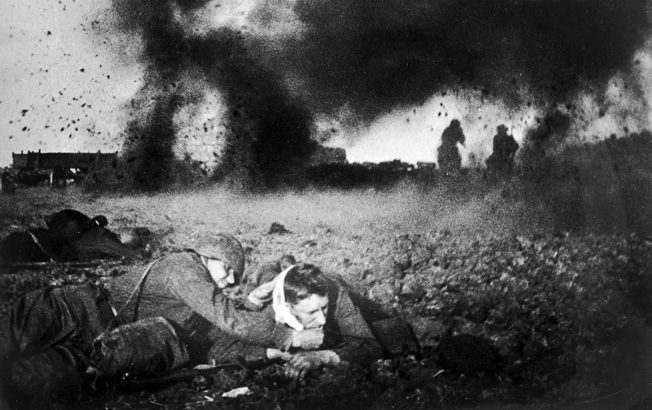
Reflecting complete confidence in its ability to take Moscow at will, OKH convinced Hitler that Stalin’s Northwestern and Southwestern Fronts could also be destroyed while an all-out lunge at Moscow was attempted. Ninth Army and Third Panzer Army, therefore, were ordered to send detachments north to Rzhev and Kalinin (respectively 200 and 120 miles northwest of Moscow), which they captured by October 14. Guderian was similarly directed to dispatch his XLVIII Panzer Corps south toward Kursk. The result was a dilution of Army Group Center’s armored strength at the time Zhukov was placing every available platoon on the likely approaches to the Soviet capital.
While the Vyaz’ma pocket was being liquidated, a halfhearted German pursuit under Hoepner’s Fourth Panzer Army commenced, using the SS Das Reich Motorized Infantry Division as its spearhead. Before long, however, Das Reich was stopped cold on the Minsk-Moscow highway by two newly formed tank brigades equipped with the excellent T-34 medium tanks. The two tank brigades fought tenaciously for four days, delaying Fourth Panzer Army’s push toward Moscow and giving Zhukov some badly needed time to move forces—including strategic reinforcements from Siberia—into position at Borodino, Yelnya, and Mozhaisk, a trio of strongpoints west of Moscow.
Guderian’s delays in pushing beyond Orel, unexpectedly fierce Soviet resistance around Borodino, and the diversion of part of Army Group Center toward Kalinin gave Zhukov time to throw together parts of 18 rifle divisions and 11 tank brigades—around 90,000 men—to hold back the gray tide. He set up a new defensive line about 75 miles west of Moscow, centered around three cities on the main approaches to the capital—Volokolamsk, Mozhaisk, and Maloyarsoslavets. But by October 15, Bock was ready to attack once again.
Maloyarsoslavets, guarded by the Forty-third Army, was the next of Zhukov’s positions hammered by the powerful LVII Panzer Corps. The city fell on October 18, but Soviet defenders were reinforced by the Thirty-third Army and managed to prevent Hoepner’s panzers from exploiting the breach. To the north, meanwhile, savage fighting at Volokolamsk further delayed the German advance until October 27, when snow, rain, and mud began to affect Bock’s mobility in a serious way.
The Miserable Russian Weather
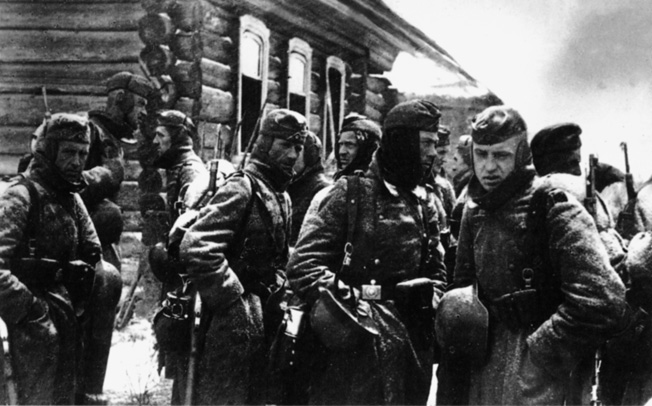
At Mozhaisk, Zhukov faced his most serious crisis. There, the SS Das Reich and 10th Panzer Divisions met stiff resistance at the nearby town of Borodino, which was guarded by the 32nd Rifle Division, some 50 tanks, and a like number of artillery pieces. It took two days for Hoepner’s panzers to grind through the defenses there, but by October 18 Das Reich had blasted its way into Mozhaisk, 55 miles from Moscow. With the fracture of the Mozhaisk Line, Germany now occupied roughly 600,000 square miles of former Soviet territory. Zhukov was running out of room.
The significance of the German victory at Borodino was not lost on Muscovites. In 1812, Napoleon’s success there had opened the doorway to French occupation of Moscow. Residents began fleeing the capital, and the government evacuated most offices to the east, although Stalin and the Army’s high command remained within the city.
As the fate of Moscow hung in the balance, Bock’s logistical vulnerabilities began catching up with him. Miserable weather and muddy roads had hampered his ability to move supplies—especially fuel and ammunition—to frontline troops. That, plus a lack of supply trains reaching his railheads, meant that from October 24 into November Army Group Center was forced to halt and settle for a war of attrition that it could ill afford. The only German gains over the next few weeks would be along Guderian’s sector to the south.
Guderian’s objective after seizing Orel was to capture Tula, 100 miles south of Moscow. Having been stymied at Mtensk until October 11, then spending 11 days bringing up additional fuel and ammunition, on October 22 Guderian sent his XXIV Panzer Corps with three infantry divisions and flanked the Soviet defenders the following day. Six days later, Guderian’s spearheads were able to pierce defenses south of Tula and attempt a direct assault on the city.
In a heroic last-stand effort, local militia, NKVD security troops, and antiaircraft crews fought off Guderian’s lead units just long enough for the 32nd Tank Brigade and two rifle divisions to come to their rescue. Deep mud limited Guderian’s mobility until the surrounding roads froze; Tula, like Moscow, gained a respite for the moment.
Zhukov’s Fresh Reserves
Guderian prepared to renew his assault on Tula by bringing up the rest of his army in a flanking movement to the east, but by early November Second Panzer Army had bypassed so many smaller Soviet units that Guderian’s right flank was seriously exposed. He posted his LIII Corps on the right to deal with threats to his line of communications, but spoiling attacks by the Soviet Third and Fiftieth Armies set off a 10-day running battle that further delayed Guderian’s drive on Tula until November 18 and forced Second Panzer Army to consume vital ammunition and fuel stocks.
By the end of October, the vast human resources of the Soviet empire had begun collecting on the Moscow axis. That month, Zhukov received 10 rifle divisions, 19 armored units, a cavalry division, five divisions of militia, and one airborne corps. During November, he would receive another 22 rifle divisions, 17 rifle brigades, 14 cavalry divisions, four armored units, and 11 ski battalions. By November 15, Zhukov and Koniev (whom at Zhukov’s request had been given command of the armies fighting at Kalinin) had assembled 38 infantry divisions, three tank divisions, and a dozen cavalry divisions, plus another 14 tank brigades. While many of Zhukov’s units would be thrown into combat with little or no training, he now had sufficient numbers to make a decent stand around his capital.

West of Moscow, Zhukov deployed seven armies—from north to south, the Thirtieth, in the north near the Moscow Sea and Volga Reservoir; the Sixteenth, along the Lama River; the Fifth, behind Mozhaisk at the town of Tuchkovo; the Thirty-third, along the Nara River south of the Minsk-Moscow highway; and the Forty-third, farther up the Nara. Below that, the Forty-ninth Army was charged with holding back Guderian’s panzers from the road below Tula, while the Fiftieth Army held Tula proper.
Zhukov, whom Stalin had warned would face a firing squad if German jackboots touched Moscow’s streets, did not wish to repeat the mistakes made by Stavka when it had dispersed its strength in piecemeal counterattacks. A ruthless man who occasionally had incompetent generals shot as examples to others, Zhukov was not afraid to give Stalin his unvarnished military opinion. However, Stalin once again insisted upon offensive action, and Zhukov had no choice but to appease the dictator by conducting a number of spoiling attacks that dispersed his reserves but did little to create decisive results.
“One Final Heave, and We Shall Triumph”
In Berlin, Hitler faced the same crossroads decision that Napoleon faced at Smolensk 129 years before: should he press on toward Moscow, or should his men go into winter quarters and rebuild their strength? OKH intelligence reports claimed that the remaining defenders were demoralized remnants of defeated field armies, plus a scratch collection of untrained militia and NKVD troops. Hitler predicted to the Wehrmacht’s operations chief, General Alfred Jodl, “One final heave, and we shall triumph.” Thus, on November 12, OKH ordered Bock and his army commanders to resume their offensive on November 15.
The second phase of Operation Typhoon called for Bock to encircle Moscow with another double envelopment. The Third and Fourth Panzer Armies (a total of 18 divisions) would attack from the north, while Guderian’s Second Panzer (nine divisions) would capture Tula and drive toward Moscow from the south. To keep Zhukov from reacting to these flanking movements, Field Marshal Guenther von Kluge’s Fourth Army would launch pinning attacks with his 14 infantry divisions along the Nara River.
The plan seemed sound, but its execution, Bock knew, would be difficult. He had the equivalent of about 38 divisions for this last phase of Typhoon—roughly half the number that participated in his initial onslaught. To the north, the Third Panzer Army had committed its reserves around Kalinin, while local Soviet counterattacks forced Bock to deploy the Second and Ninth Armies on his exposed flanks.
Bock’s logistical constraints also had not eased. He had no significant stockpiles at jumping-off points for his men, and the OKH quartermaster department, unable to supply Army Group Center’s requirements of 30 trains per day, simply cut the army group’s quota by one-fourth; even that reduced amount did not get through to Bock’s forward railheads. It would be a close battle for both armies.
Deciding the Fate of Moscow
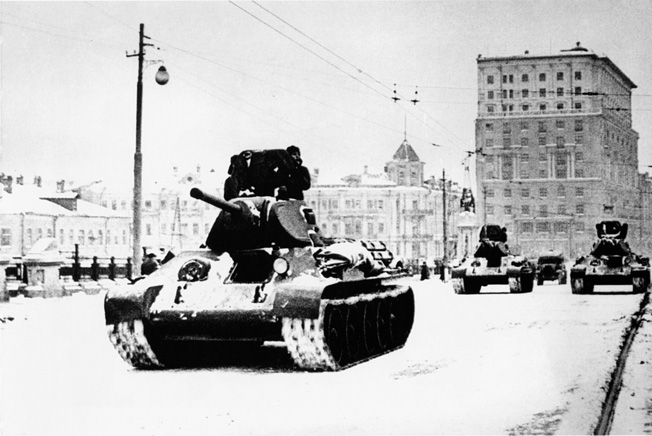
The final struggle for Moscow opened with a three-division attack by Ninth Army’s XXVII Corps, supported by the 1st Panzer Division, against Maj. Gen. Dmitri Lelyushenko’s Thirtieth Army at the Moscow Sea. The Thirtieth, still recovering from bitter fighting around Kalinin, fell back toward Klin, 52 miles from the capital. This retreat allowed Third Panzer Army to move over the Lama River, 60 miles from Moscow.
On November 18, the main German thrust began as Fourth Panzer Army’s V Corps and XLVI Panzer Corps, six divisions in all, ripped open a hole between the Thirtieth and Sixteenth Armies. The Sixteenth, commanded by Maj. Gen. Konstantin Rokossovsky, was forced to withdraw east toward Istra, 36 miles west of Moscow, leaving a gap between the two armies that Hoepner obligingly exploited with two corps.
By November 23, Klin was in German hands, and Thirtieth Army was in peril. But with Koniev launching division-sized counterattacks from the Kalinin region, Bock could not afford to leave his left flank open. He ordered Col. Gen. Adolf Strauss’s Ninth Army to assume the defensive and keep Koniev’s forces away from his panzers moving against Moscow.
While Thirtieth Army was falling back toward the Volga Reservoir, 35 miles north of the Kremlin, Rokossovky’s Sixteenth Army, west of Moscow, was taking a beating around Istra. There, his 78th Rifle Division, newly arrived from Siberia, was putting up a desperate defense against the SS Das Reich Division. The 78th conceded the town on November 27, but not before inflicting 926 casualties on Das Reich and taking a good deal of the fight out of that elite unit. In addition to inflicting German casualties, the battle for Istra bought Zhukov critical time to establish yet another defensive line 21 miles northwest of Moscow.
Time was, for the moment, on Zhukov’s side. The delaying actions around Klin and Istra allowed him to withdraw troops east and avoid another pocket disaster, while harsh weather and supply shortages seriously hampered Bock’s ability to move forward. But Bock had one last attack left in his army group, and no one knew whether it would end inside or outside the Kremlin walls.
On November 27, advance units of the LVI Panzer Corps managed to reach the Moscow-Volga Canal, but they were thrown back by lead elements of the First Shock Army, and forward momentum on the north side of the capital was lost. Northwest of Moscow, on November 30 the 2nd Panzer Division captured the town of Krasnaya Polyana, 17 miles away, but fierce resistance by Rokossovsky’s army, increasingly severe weather, and fuel shortages stopped Hoepner’s advance there.
Kluge’a Late Attack
To the south, around Tula, Guderian spent late November fending off counterattacks against his line of communication and gathering fuel to launch one last attack. Meanwhile, at Tula, the Red Army moved replacements into Lt. Gen. Ivan Boldin’s Fiftieth Army. Spoiling attacks by Boldin’s Siberian 413th Rifle Division damaged Guderian’s right flank badly enough to require him to throw off divisions to protect his flank, delaying his planned encirclement of the city.
It was not until November 24 that Guderian was able to send his XXIV Panzer Corps northeast of Tula in an effort to encircle the city. But his all-out effort ground down against unexpectedly strong Soviet defenses, and Guderian, to his disgust, received no help from the plodding Kluge, whose Fourth Army provided negligible support from its divisions north of Guderian’s advance. Although German tanks briefly cut the Tula-Moscow highway on December 3, the next day armor dispatched by Zhukov forced Guderian to withdraw from the city’s outskirts and stand on the defensive.
South of the Minsk-Moscow highway, Kluge’s army sat idle through the late November maelstrom, keeping watch along the Nara River and giving Zhukov the opportunity to move units from his Fifth and Thirty-third Armies north to assist the hard-pressed Rokossovsky. It was not until the early hours of December 1 that Kluge launched a four-division attack against well-prepared Soviet defenses. Kluge’s troops performed superbly, but by then Hoepner’s Fourth Panzer Army had been stopped, and there was little that the Fourth Army could do at this late date. After Zhukov moved his reserves back to the center to support the crumbing Thirty-third Army, Kluge retired across the Nara, effectively quitting the battle. As Zhukov later commented, “In the absence of attacks at the center we were able to shift all our reserves, down to divisional reserves, from the center of the front to parry the enemy’s strike forces on the flanks.”
Rolling the Germans Back
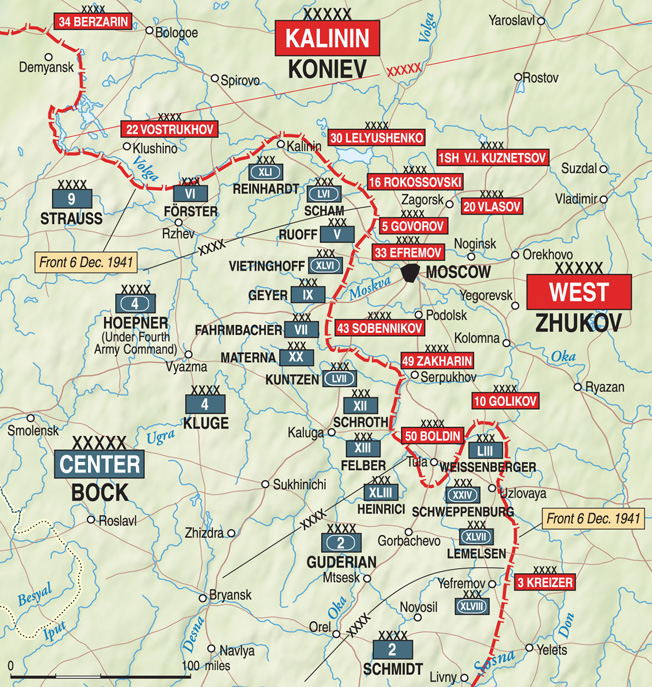
Hitler’s Wehrmacht had reached its high- water mark. From the Moscow suburb of Khimki, less than 12 miles from the Kremlin, reconnaissance troops allegedly could see the gleaming onion domes of the city in the distance. But they were dangerously low on fuel and ammunition. They had sustained around 155,000 casualties and lost over 700 tanks in the second phase of Typhoon, and although OKH did not know it, the Red Army now held a numerical advantage. On December 8, Hitler agreed to suspend offensive operations, citing uncooperative weather, but ordered Bock to hold all conquered territory.
Unbeknownst to OKH, three fresh armies— the First Shock, Tenth, and Twentieth—had arrived at Moscow, and on November 30 Stalin approved a counteroffensive proposal employing six armies. The new armies lacked significant armor, but Zhukov planned to use them to pull the steel fangs out of Bock’s panzer divisions.
Soviet counterattacks began on December 5 at the north end of the line, east of Klin, where the Third Panzer Army deployed three panzer and two motorized infantry divisions. Col. Gen. Hans Reinhardt, who had replaced Hoth as commander of Third Panzer after Typhoon’s launch, made the mistake of keeping his few operational tanks, only around 80 or so by now, close to his front lines. They were therefore unable to act as a mobile reserve to plug cracks in his front and were vulnerable to a rapid thrust.
On the morning of December 6, Thirtieth Army flung three rifle divisions and two tank brigades at Reinhardt’s overstretched 14th and 36th Motorized Infantry Divisions. The First Shock Army joined in the attack, and Twentieth and Sixteenth Armies began pressing attacks along the juncture of the Third and Fourth Panzer Armies. Reinhardt ordered Third Panzer to fall back upon Klin, while Hoepner withdrew Fourth Panzer Army to Istra.
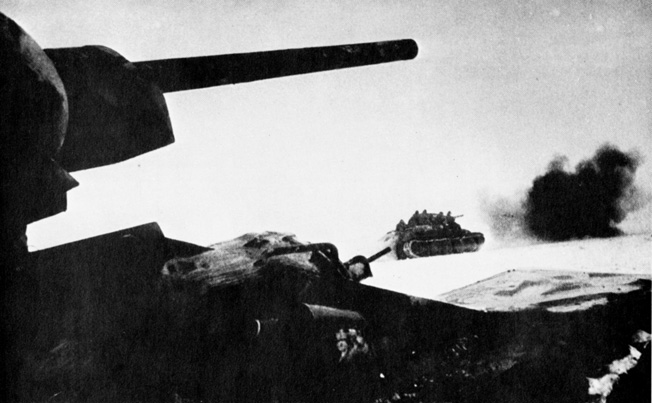
As Hoepner and Reinhardt were pulling back, the Soviet Fifth Army joined the battle, and Third Panzer suffered heavy losses in artillery and vehicles as Reinhardt tried to cobble together a Kampfgruppe (battle group) from two panzer divisions to hold back the red tide. Miserable weather and fuel shortages impeded cooperation between the two panzer armies, and by December 11 Rokossovsky had pushed the Germans out of Istra. Bock’s left wing was in danger of collapse.
On December 12, Rokossovsky moved in for the kill, sending two tank brigades, two motorized regiments, and two cavalry units around Third Panzer Army to cut off its line of retreat. His force captured the road from Klin on December 14, isolating four panzer divisions plus the hard-pressed 14th Motorized Infantry Division. Leaving behind much of their heavy equipment, the divisions trapped at Klin forced open the road to Kalinin just long enough to escape the rapidly closing noose, and by December 15 Third and Fourth Panzer Armies again were in retreat.
To the south, around Tula, Boldin’s Fiftieth Army, plus reinforcements from the I Guards Cavalry Corps and the newly formed Tenth Army, battered Guderian’s front and flanks. At the same time, Stavka sent two reinforcing armies toward Tula, and by early December those armies had converged upon Second Panzer’s flanks. As in the north, three of Guderian’s infantry divisions were threatened with encirclement, but all managed to withdraw southwest with heavy losses. Soviet thrusts at the juncture between Fourth Army and Second Panzer Army threatened to isolate Guderian, and by December 12 he was in retreat toward Orel. Moscow had been saved.
Aftermath of Operation Typhoon
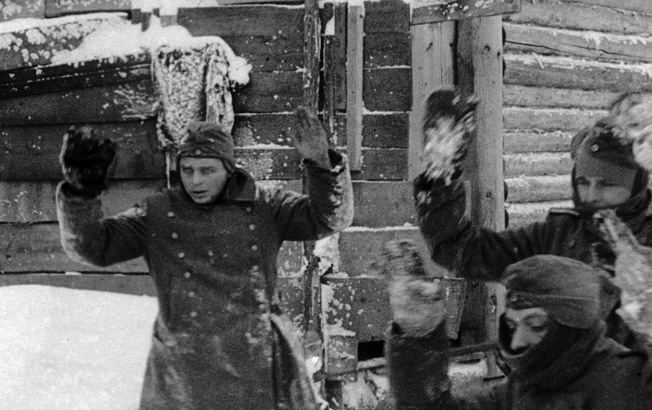
Operation Typhoon was a near run thing for the Soviet Union. From September 30 to December 15, the Red Army sustained roughly 1.5 million casualties (some 350,000 in December alone), and the Soviet government had been forced to evacuate its capital. Army Group Center, for its part, lost over 150,000 men. Particularly crippling for the Ostheer was the loss of heavy equipment—as many as 800 tanks, 983 artillery pieces, 473 heavy mortars, and 800 antitank guns were destroyed or abandoned during December alone.
Perhaps the greatest damage to the Nazi war machine was psychological. The “subhuman” Slavic troops had shattered the myth of Wehrmacht invincibility. Hitler’s confidence in his generals was irredeemably shaken, and in short order he relieved the head of OKH and took personal command of the Army. He sacked Bock, three of the six army commanders involved in Typhoon (Guderian, Hoepner, and Strauss), and four of the 22 corps commanders.
The first phase of Operation Typhoon, culminating in the liquidation of the Vyaz’ma and Bryansk pockets, was brilliantly conceived and almost flawlessly executed. Its few shortcomings can be attributed to logistical shortages and to Guderian’s failure to close the Bryansk pocket aggressively, allowing a number of Soviet troops to escape to Tula, where they would join the reconstituted Fiftieth Army in defense of that city.
The operational pause during early November, when the Red Army was reeling, was due to structural flaws in the Ostheer that prevented adequate fuel and ammunition from reaching Army Group Center’s front lines. By the time Bock was ready to resume his attack, both numbers and climate had begun to favor Zhukov.
It was the second phase of Operation Typhoon, the last push to Moscow, that was the most flawed of all. Harkening back to the German experience at the Marne in World War I, when Germany might have defeated France had it thrown in its last reserves, both OKH and Bock were prepared to commit every remaining soldier on the assumption that the Red Army simply had no reserves left. Hitler allowed himself to be persuaded by overly optimistic reports claiming that the Red Army and Stalin’s dictatorship had sustained so many casualties that they could be toppled with one last shove. When trained reinforcements arrived from Siberia and the Far East, and when Stavka proved capable of forming fresh armies, the critical assumption underlying Hitler’s lunge against the Soviet capital evaporated. The Soviet Union would not suffer the fate of Poland, France, and the Low Countries.
Back to the issue this appears in
Join The Conversation
Leave a reply cancel reply.
You must be logged in to post a comment.
Share This Article
- via= " class="share-btn twitter">
Related Articles
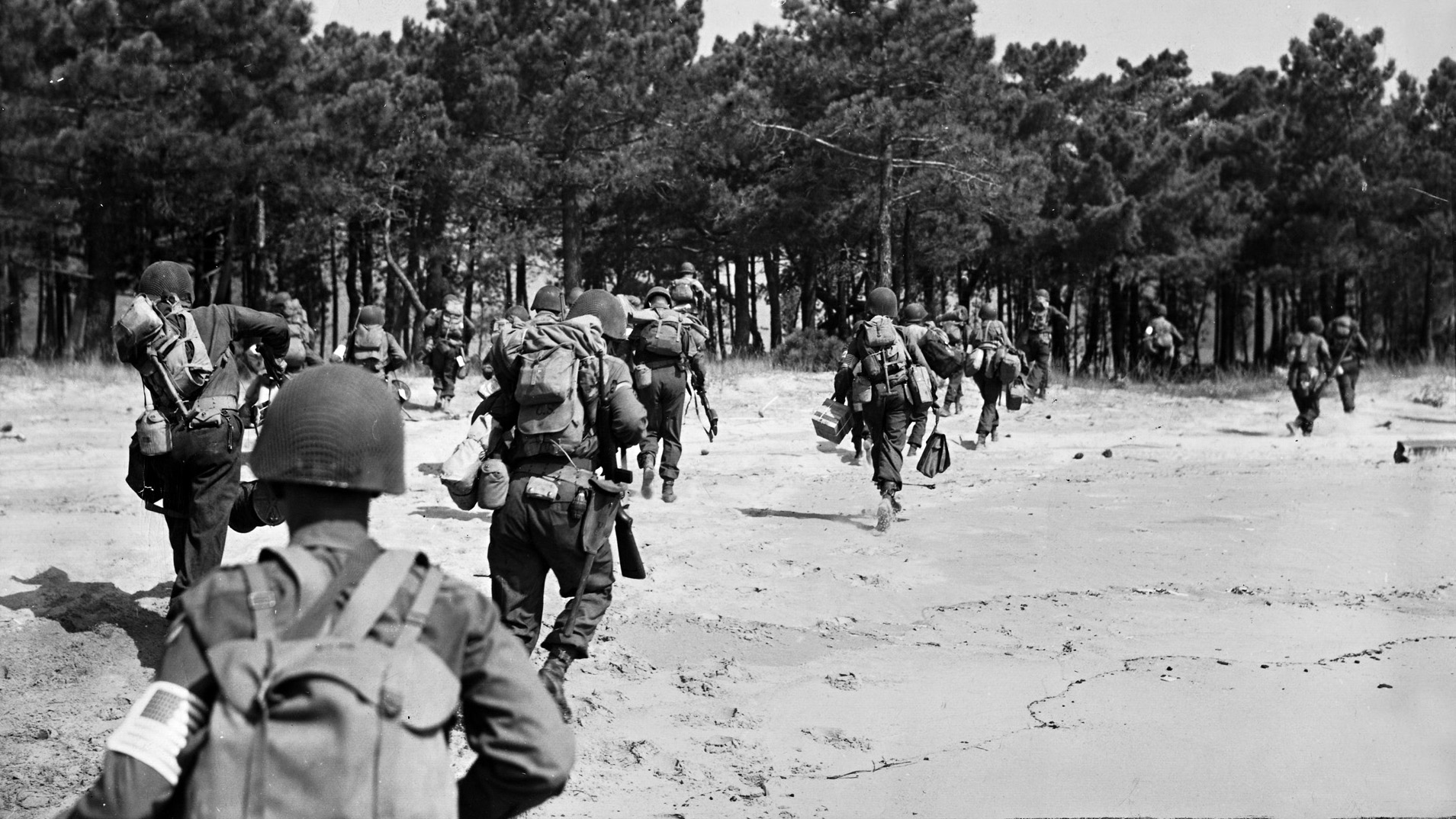
From the Alamo to the Riviera

Military Games
World War II Games of June 2021
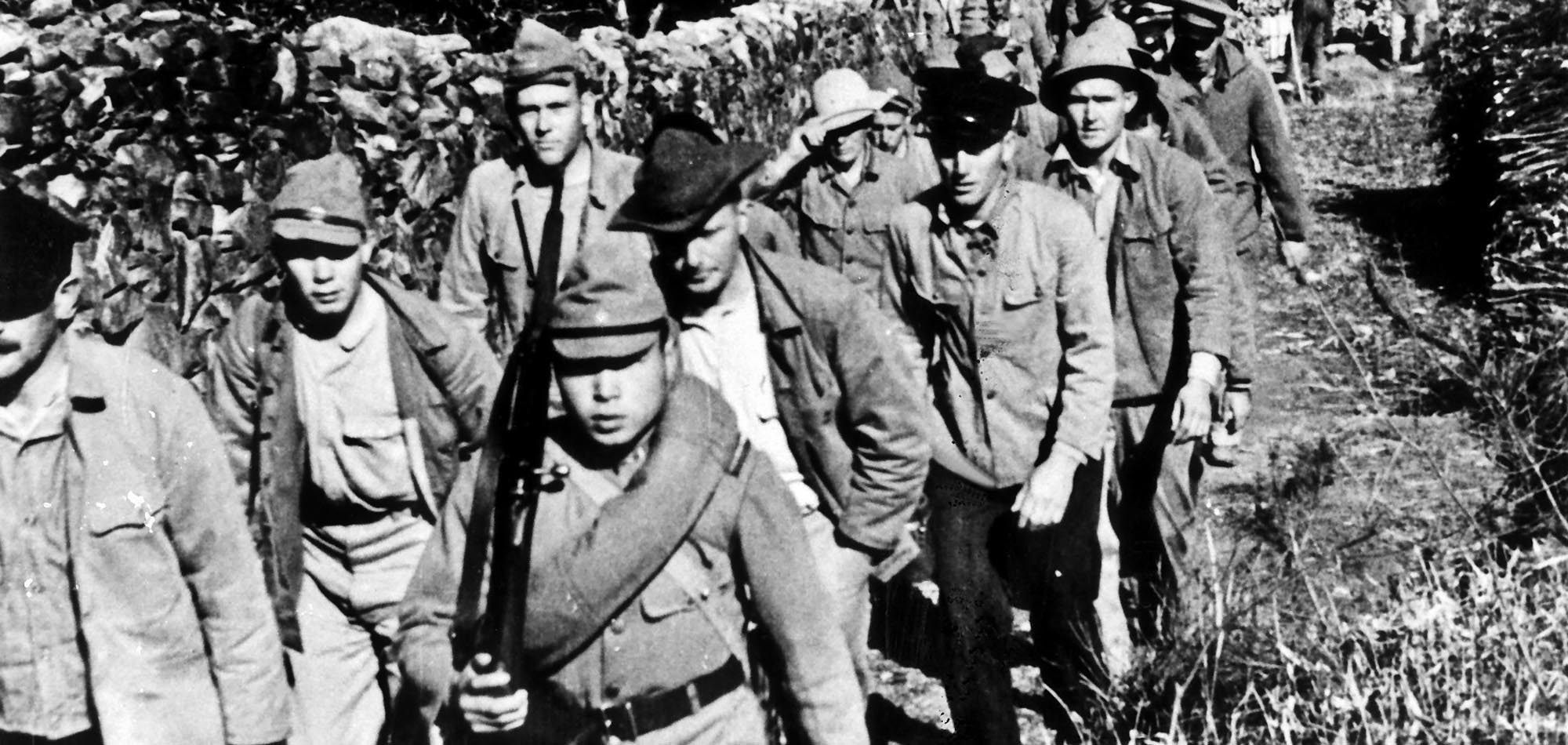
Last of the Gilbert Islands Coastwatchers

The Heroes of Hill 192
From around the network.

Book Reviews
Mark Lee Gardner’s ‘The Earth is All that’s Lasts’
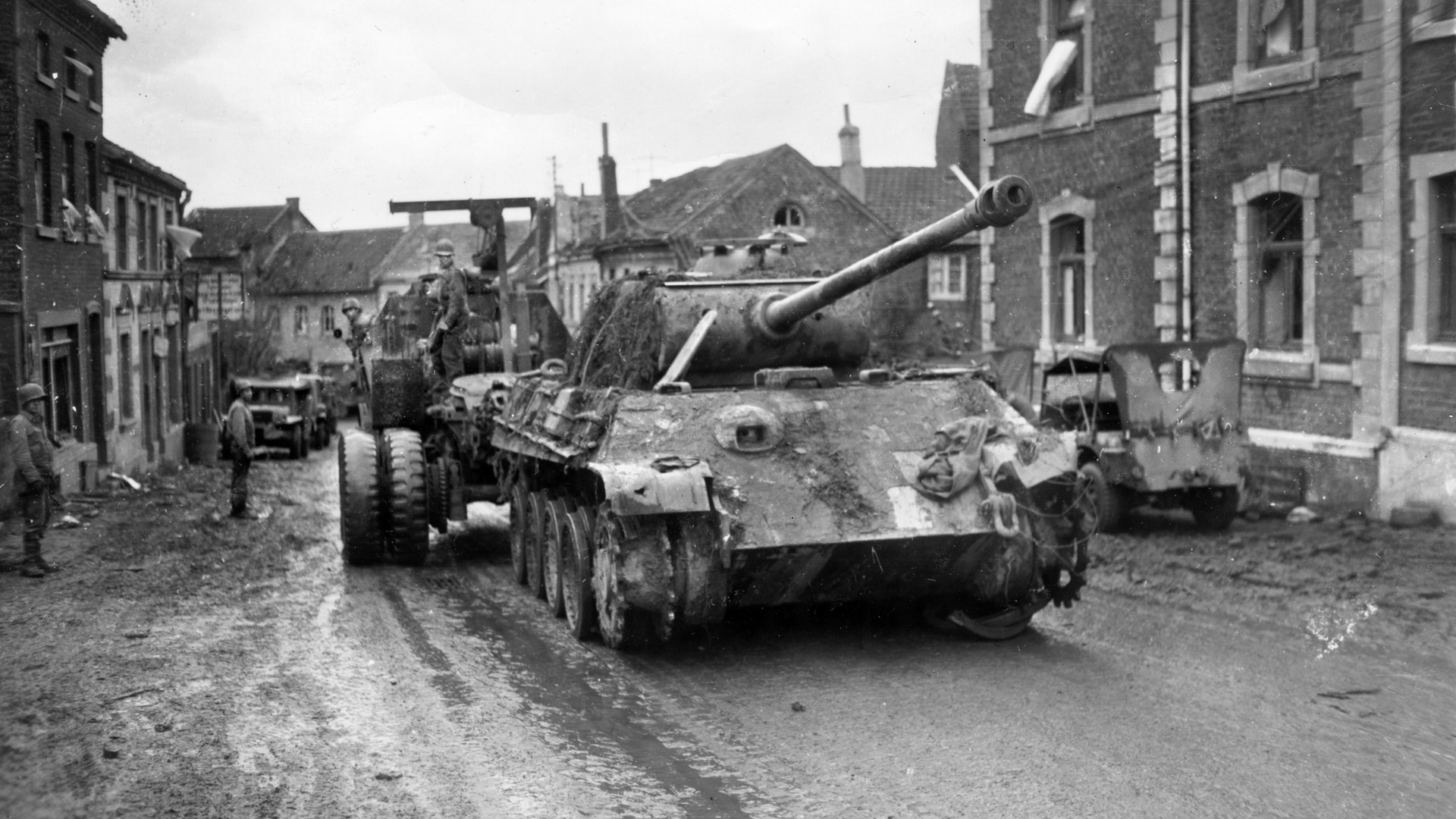
Latest Posts
Cracking the Geilenkirchen Salient
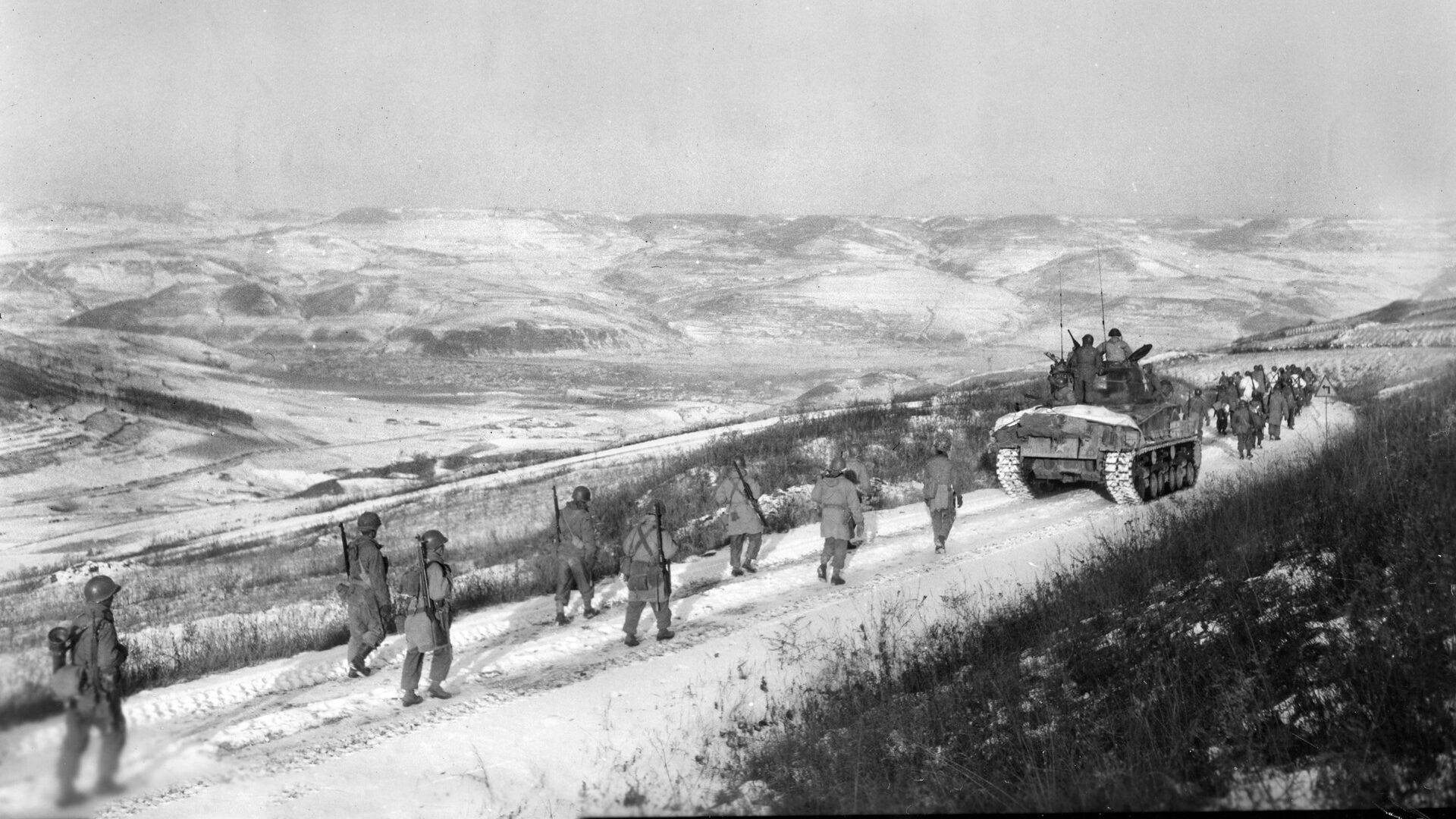
Bloodbath at the Chosin
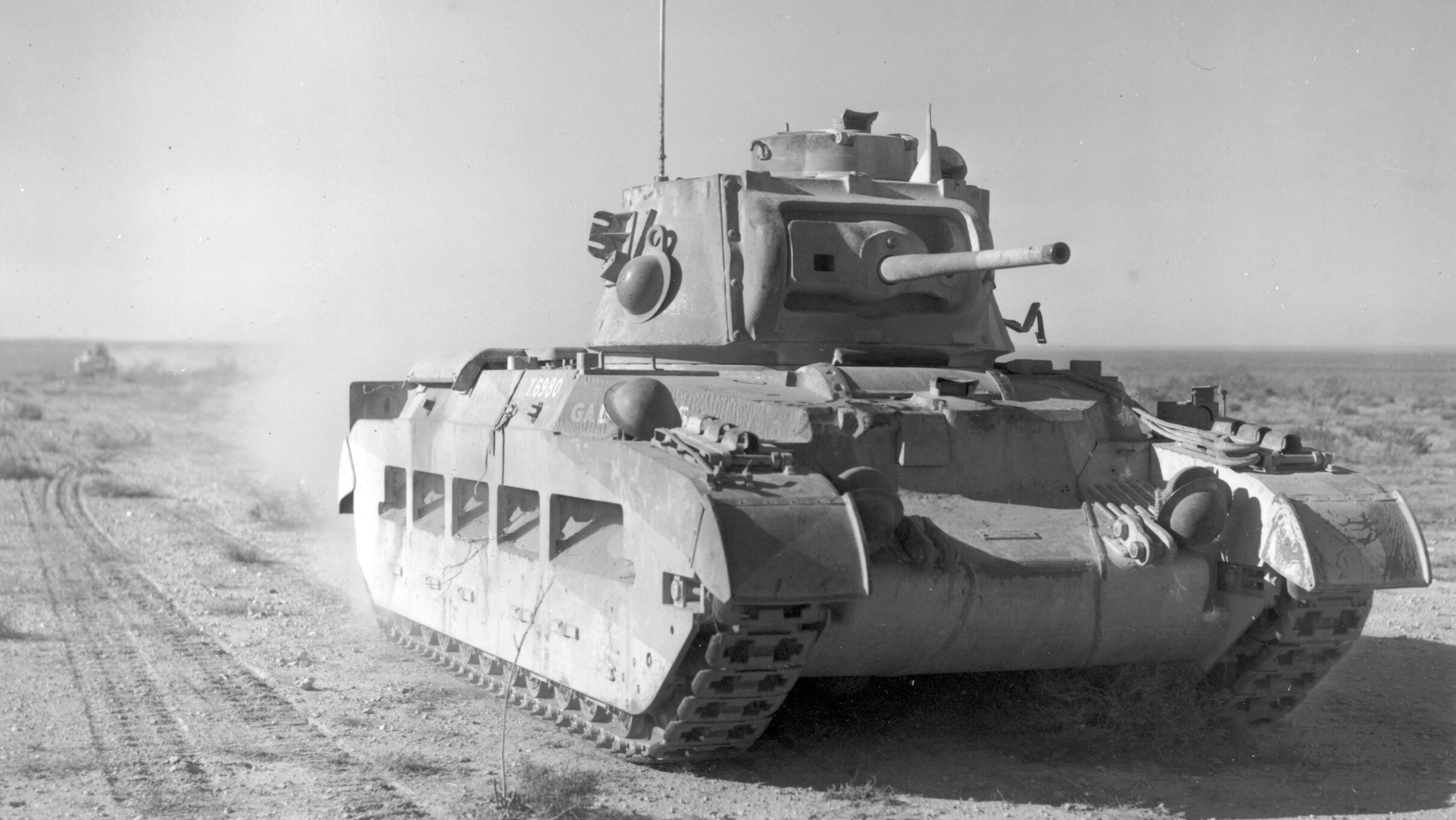
A Daring Desert Campaign

Currency: GBP
- Worldwide Delivery
Mooring Warps and Mooring Lines
- LIROS 3 Strand Polyester Mooring Warps
- LIROS Braided Dockline Mooring Warps
- LIROS Classic Mooring Warps
- LIROS Green Wave 3 Strand Mooring Warps
- LIROS Handy Elastic Mooring Warps
- LIROS Moorex12 Mooring Warps
- LIROS Octoplait Polyester Mooring Warps
- LIROS Polypropylene Floating Mooring Warps
- LIROS Super Yacht Mooring Polyester Docklines
- Marlow Blue Ocean Dockline
Mooring Accessories
- Mooring Cleats and Fairleads
- Mooring Compensators
- Mooring Shackles
- Mooring Swivels
Mooring Strops
- LIROS 3 Strand Nylon Mooring Strops
- LIROS Anchorplait Nylon Mooring Strops
- Small Boat and RIB Mooring Strops
Mooring Bridles
- V shape Mooring Bridles
- Y shape Mooring Bridles
Mooring Strops with chain centre section
- 3 Strand / Chain / 3 Strand
- Anchorplait / Chain / Anchorplait
Bonomi Mooring Cleats
- Majoni Fenders
- Polyform Norway Fenders
- Dock Fenders
- Fender Ropes and Accessories
- Ocean Inflatable Fenders
Mooring Buoys
Max power bow thrusters.
- Coastline Bow Thruster Accessories
50 metre / 100 metre Rates - Mooring
Mooring information.
- Mooring Warps Size Guide
- Mooring Lines - LIROS Recommended Diameters
- Mooring Rope Selection Guide
- Mooring Warp Length and Configuration Guide
- How to estimate the length of a single line Mooring Strop
- Mooring Ropes - Break Load Chart
- Mooring Compensator Advisory
- Rope Cockling Information
- Fender Size Guide
- Majoni Fender Guide
- Polyform Norway Fender Inflation Guide
Custom Build Instructions
- More Article and Guides >
Anchor Warps Spliced to Chain
- LIROS 3 Strand Nylon Spliced to Chain
- LIROS 3 Strand Polyester Spliced to Chain
- LIROS Anchorplait Nylon Spliced to Chain
- LIROS Octoplait Polyester Spliced to Chain
Anchor Warps
- Leaded Anchor Warp
- LIROS 3 Strand Nylon Anchor Warps
- LIROS 3 Strand Polyester Anchor Warps
- LIROS Anchorplait Nylon Anchor Warps
- LIROS Octoplait Polyester Anchor Warps
- Aluminium Anchors
- Galvanised Anchors
- Stainless Steel Anchors
Calibrated Anchor Chain
- Cromox G6 Stainless Steel Chain
- G4 Calibrated Stainless Steel Anchor Chain
- Lofrans Grade 40
- MF DAMS Grade 70
- MF Grade 40
- Titan Grade 43
Clearance Chain
Anchoring accessories.
- Anchor Connectors
- Anchor Trip Hooks and Rings
- Anchoring Shackles
- Bow Rollers and Fittings
- Chain and Anchor Stoppers
- Chain Links and Markers
50 / 100 metre Rates - Anchoring
Chain snubbers.
- Chain Hooks, Grabs and Grippers
- Chain Snubbing Bridles
- Chain Snubbing Strops
Drogue Warps and Bridles
- Lewmar Windlasses
- Lofrans Windlasses
- Maxwell Windlasses
- Quick Windlasses
Windlass Accessories
- Coastline Windlass Accessories
- Lewmar Windlass Accessories
- Lofrans Windlass Accessories
- Lofrans Windlass Replacement Parts
- Maxwell Windlass Accessories
- Quick Windlass Accessories
Anchoring Information
- How To Choose A Main Anchor
- Anchoring System Assessment
- Anchor Chain and Rope Size Guide
- The Jimmy Green Guide to the Best Anchor Ropes
- What Size Anchor Do I Need?
- Anchor Size Guides
- Anchor Rope Break Load and Chain Compatibility Chart
- How to Choose Your Anchor Chain
- How to Establish the Correct Anchor Chain Calibration?
- Calibrated Anchor Chain - General Information
- Calibrated Anchor Chain Quality Control
- Calibrated Chain - Break Load and Weight Guide
- Galvanising - Managing Performance and Endurance expectation
- Can Galvanised Steel be used with Stainless Steel?
- Windlass Selection Guide
- More Articles and Guides
Stainless Steel Wire Rigging and Wire Rope
- 1x19 Wire Rigging
- 7x19 Flexible Wire Rigging
- Compacted Strand Wire Rigging
- Insulated 1x19 Wire Backstays
Wire Rigging Fittings
- Swaged Terminals
- Swageless Terminals
- Turnbuckles / Rigging screws
- Turnbuckle Components
- Backstay Insulators
- Wire Terminals
Rigging Accessories
- Backing Plates
- Backstay Adjuster and Fittings
- Backstay Blocks
- Pins, Rings and Nuts
- Rigging Chafe Protection
Fibre Rigging
- DynIce Dux Fibre Rigging
- LIROS D-Pro Static Rigging
- LIROS D-Pro-XTR Fibre Rigging
- Marlow Excel D12 MAX 78 Rigging
- Marlow M-Rig Max Rigging
Fibre Rigging Fittings
- Bluewave Rope Terminals
- Colligo Marine Terminals
Dinghy Rigging
- Dinghy Rigging Fittings
- Fibre Dinghy Rigging
- Stainless Steel Dinghy Rigging
Wind Indicators
Guard wires, guardrails and guardrail webbing.
- Guard Rail Fittings
- Guard Rails in Fibre and Webbing
- Guard Wire Accessories
- Guard Wires
Furling Systems
- Anti-torsion Stays
- Headsail Reefing Furlers
- Straight Luff Furlers
- Top Down Furlers
Furling Accessories
- Continuous Furling Line Accessories
- Furling Line Accessories
50 / 100 metre Rates - Wire and Fibre
Standing rigging assistance.
- More Articles and Guides >
- Cruising Halyards
- Performance Halyards
- Dinghy Halyards
Rigging Shackles
- Bronze Snap Shackles
- Captive and Key Pin Shackles
- hamma™ Snap Shackles
- Selden Snap Shackles
- Soft Shackles
- Standard Snap Shackles
- Tylaska End Fittings
- Wichard Snap Shackles
Lashing, Lacing and Lanyards
- LIROS 3 Strand Lashing, Lacing and Lanyards
- LIROS Braided Lashing, Lacing and Lanyards
- Cruising Sheets
- Performance Sheets
- Dinghy Sheets
- Continuous Sheets
- Tapered Sheets
Running Rigging Accessories
- Anti-Chafe Rope Protection
- Barton Sail Handling
- Lazy Jack Sail Handling
- Rodkickers, Boomstruts
- Sail Handling Accessories
- Slab Reefing
Shock Cord and Fittings
Control lines.
- Cruising Control Lines
- Performance Control Lines
- Dinghy Control Lines
- Continuous Control Lines
Classic Ropes
- 50 / 100 metres - Classic
- Classic Control Lines
- Classic Docklines
- Classic Halyards
- Classic Sheets
- LIROS Classic 3 Strand Polyester
50 / 100 metre Rates - Running Rigging
- 50 / 100 metres - Cruising Ropes
- 50 / 100 metres - Dinghy Ropes
- 50 / 100 metres - Lashing and Lanyards
- 50 / 100 metres - Performance Ropes
- LIROS Ropes
- Marlow Ropes
Running Rigging Resources
- Running Rigging Rope Fibres and Construction Explained
- How to Select a Suitable Halyard Rope
- How to select Sheets and Guys
- Dyneema Rope - Cruising and Racing Comparison
- Dinghy Rope Selection Guide
- Rope Measurement Information
- Running Rigging - LIROS Recommended Line Diameters
- Running Rigging Break Load Comparison Chart
- Colour Coding for Running Rigging
- Selecting the right type of block, plain, roller or ball bearing
- Replacing your Furling Line
- Recycling Rope
- Running Rigging Glossary
Custom Build Instructions for Sheets, Halyards, Control Lines
Low friction rings, plain bearing blocks.
- Barton Blocks
- Harken Element Blocks
- Seasure 25mm Blocks
- Selden Yacht Blocks
Wooden Blocks
Ball bearing blocks.
- Barton Ball Bearing Blocks
- Harken Ball Bearing Blocks
- Holt Dynamic Blocks
- Selden Ball Bearing Blocks
Ratchet Blocks
- Harken Ratchet Blocks
- Selden Ratchet Blocks
Roller Bearing Blocks
- Harken Black Magic Blocks
- Selden Roller Bearing Blocks
Clutches and Organisers
- Barton Clutches and Organisers
- Lewmar Clutches
- Spinlock Clutches and Organisers
Genoa Car Systems
- Barton Genoa Sheeting
- Harken Genoa Systems
- Lewmar HTX Genoa Systems
Traveller Systems
- Barton Traveller Systems
- Harken Traveller Systems
Deck Fittings
- Bungs and Hatches
- Bushes and Fairleads
- Deck Eyes, Straps and Hooks
- Pad Eyes, U Bolts and Eye Bolts
Rudder and Transom Fittings
- Pintles and Gudgeons
- Tiller Extensions and Joints
Stanchion Blocks and Fairleads
Snatch blocks.
- Barton K Cam Cleats
- Harken Ball Bearing Cam Cleats
- Holt Cam Cleats
- Selden Cam Cleats
- Spinlock PXR Cleats
Block and Tackle Purchase Systems
- Barton Winches, Snubbers and Winchers
- Coastline Electric Winch Accessories
- Harken Winches, Handles and Accessories
- Karver Winches
- Lewmar Winches, Handles and Accessories
- Winch Servicing and Accessories
Deck Hardware Support
- Blocks and Pulleys Selection Guide
- Barton High Load Eyes
- Dyneema Low Friction Rings Comparison
- Seldén Block Selection Guide
- Barton Track Selection Guide
- Barton Traveller Systems Selection Guide
- Harken Winch Selection Guide
- Karver Winch Comparison Chart
- Lewmar Winch Selection Guide - PDF
- Winch Servicing Guide
Sailing Flags
- Courtesy Flags
- Red Ensigns
- Blue Ensigns
- Flag Accessories
- Flag Staffs and Sockets
- Flag Making and Repair
- Signal Code Flags
- Galvanised Shackles
- Stainless Steel Shackles
- Titanium Shackles
- Webbing only
- Webbing Restraint Straps
- Webbing Sail Ties
- Webbing Soft Shackles
Hatches and Portlights
Sail care and repair.
- Sail Sewing
Maintenance
- Antifouling
- Fillers and Sealants
- Primers and Thinners
- PROtect Tape
Fixings and Fastenings
- Monel Rivets
- Screws, Bolts, Nuts and Washers
- U Bolts, Eye Bolts and Pad Eyes
Splicing Accessories
- Fids and Tools
- Knives and Scissors
General Chandlery
- Barrier Ropes
- Canvas Bags and Accessories
- Carabiners and Hooks
- Netting and Accessories
- Rope Ladders
Seago Boats and Tenders
Chandlery information, flag articles.
- Flag Size Guide
- Bending and Hoisting Methods for Sailing Flags
- Courtesy Flags Identification, Labelling and Stowage
- Courtesy Flag Map
- Flag Etiquette and Information
- Glossary of Flag Terms and Parts of a Flag
- Making and Repairing Flags
- Signal Code Message Definitions
Other Chandlery Articles
- Anchorplait Splicing Instructions
- Antifoul Coverage Information
- Hawk Wind Indicator Selection Guide
- Petersen Stainless - Upset Forging Information
- Speedy Stitcher Sewing Instructions
- Thimble Dimensions and Compatible Shackles
Jackstays and Jacklines
- Webbing Jackstays
- Stainless Steel Wire Jackstay Lifelines
- Fibre Jackstay Lifelines
- Jackstay and Lifeline Accessories
Safety Lines
Lifejackets.
- Children's Life Jackets
- Crewsaver Lifejackets
- Seago Lifejackets
- Spinlock Lifejackets
Buoyancy Aids
Life jackets accessories.
- Lifejacket Lights
- Lifejacket Rearming Kits
- Lifejacket Spray Hoods
Overboard Recovery
- Lifebuoy Accessories
- Purchase Systems
- Slings and Throwlines
Floating Rope
- LIROS Multifilament White Polypropylene
- LIROS Yellow Floating Safety Rope
- Danbuoy Accessories
- Jimmy Green Danbuoys
- Jonbuoy Danbuoys
- Seago Danbuoys
- Liferaft Accessories
- Seago Liferafts
Safety Accessories
- Fire Safety
- Grab Bag Contents
- Grab Bags and Polybottles
- Handheld VHF Radios
- Sea Anchors and Drogues
Safety Resources
- Guard Wires - Inspection and Replacement Guidance
- Guard Wire Stud Terminal Dimensions
- Webbing Jackstays Guidance
- Webbing Jackstays - Custom Build Instructions
- Danbuoy Selection Guide
- Danbuoy Instructions - 3 piece Telescopic - Offshore
- Liferaft Selection Guide
- Liferaft Servicing
- Man Overboard Equipment - World Sailing Compliance
- Marine Safety Information Links
- Safety Marine Equipment List for UK Pleasure Vessels
Sailing Clothing
- Sailing Jackets
- Sailing Trousers
- Thermal Layers
Leisure Wear
Accessories.
- Rain Jackets
- Sweatshirts
Sailing Footwear
- Dinghy Boots and Shoes
- Sailing Wellies
Leisure Footwear
- Walking Shoes
Sailing Accessories
- Sailing Bags and Holdalls
- Sailing Gloves
- Sailing Kneepads
Clothing Clearance
Clothing guide.
- What to wear Sailing
- Helly Hansen Mens Jacket and Pant Size Guide
- Helly Hansen Womens Sailing Jacket and Pant Size Guide
- Lazy Jacks Mens and Womens Size Charts
- Musto Men's and Women's Size Charts
- Old Guys Rule Size Guide
- Sailing Gloves Size Guides
- Weird Fish Clothing Size Charts
The Jimmy Green Clothing Store
Lower Fore St, Beer, East Devon, EX12 3EG
- Adria Bandiere
- Anchor Marine
- Anchor Right
- August Race
- Barton Marine
- Blue Performance
- Brierley Lifting
- Brook International
- Brookes & Adams
- Captain Currey
- Chaineries Limousines
- Coastline Technology
- Colligo Marine
- Cyclops Marine
- Douglas Marine
- Ecoworks Marine
- Exposure OLAS
- Fire Safety Stick
- Fortress Marine Anchors
- Hawk Marine Products
- Helly Hansen
- International
- Jimmy Green Marine
- Maillon Rapide
- Mantus Marine
- Marling Leek
- Meridian Zero
- MF Catenificio
- Ocean Fenders
- Ocean Safety
- Old Guys Rule
- Petersen Stainless
- Polyform Norway
- PSP Marine Tape
- Sidermarine
- Stewart Manufacturing Inc
- Team McLube
- Technical Marine Supplies
- Titan Marine (CMP)
- Ultramarine
- Waterline Design
- William Hackett
Clearance August Race Boat Cleaning Kit £26.00
Clearance LIROS Racer Dyneema £55.08
Clearance Folding Stock Anchor £123.25
Clearance LIROS Herkules £0.00
Clearance Barton Size 0 Ball Bearing Blocks - 5mm £10.13
Clearance Marlow Blue Ocean® Doublebraid £18.48
Mooring Clearance
Anchoring clearance, standing rigging clearance, running rigging clearance, deck hardware clearance, chandlery clearance, safety clearance.
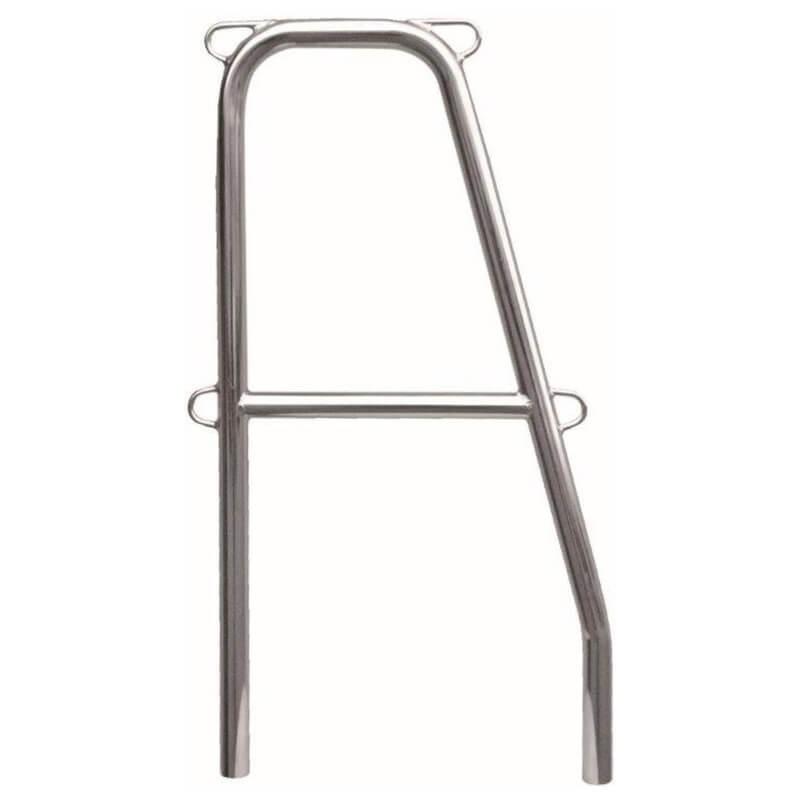
Heavy Duty Gate Stanchions
AISI 316 stainless steel
More Information
These heavy duty stanchion gates are manufactured with a 1.5mm wall thickness featuring 4 welded lugs to securely fit the guardrail and gate pelican hook.
Fits most stanchion bases to suite 25mm OD tube,
Fixing hole in-line with guardrail – suitable for drilling to suite existing base,
OD tube with 2 lengths available: 61cm and 74cm.
Material: AISI 316 stainless steel.
Stanchion Base - Rectangular
Stanchion base - triangular, you may also like, mantus rail clamps, angled stanchion base - triangular, liros 8plait white polyester, waterline design leather protection for guardwire terminals.
£15.00 -40%
Guardrail Netting
Clearance wire protection sheath, holt rondo sail wheels, ocean guard wire terminal cover 2pack, vitesse stanchion socket, seasure shroud rollers, blue performance sea rail cover, meridian zero sailguard, ocean clip-on stanchion cover 4pack, liros 8plait black polyester - 50 and 100 metre reels.

IMAGES
COMMENTS
Yacht Guard Rails & Life Line Fittings. For your safety and peace of mind. Sta-Lok have designed an extensive range of guard rail and lifeline hardware. This extensive range of 316 stainless steel hardware is designed to fit 3mm (1/8") to 6mm (1/4") stainless steel wire.
Guard Rails form a vital safety barrier around your yacht, preventing any crew member from falling overboard. Jimmy Green Marine supply a range of individual fittings designed to improve the efficiency of any installation by providing an extra means of adjustment or a quick release option e.g. Guardrail Adjustment - it is important that guard ...
Stanchions Gates, Deck Socket, Guardrail Cable and More Usually Out for Delivery the Same Working Day, UK Only. Login / Register. ... Guard rail wire bracing leg allowing an opening for a gate, and keeping tension on the wire. ... And for Bird Roosting Control and 4, 5, 6mm can be used for Yacht Guardrails. Wire Rope 1x19 Firm A4.
Guard Wires, also known as Guard Rails and Lifelines, are fitted through Deck Stanchions positioned along the toe rail or gunwale between the pulpit and pushpit rails on yachts and boats to help prevent crew members from falling overboard. ... Gates are commonly fitted amidships to port and starboard on larger yachts. Gates require a pair of ...
Popular tubing for marine use Oval tubes are our most popular tubing for marine use and are predominantly used for onboard boat railings such as pulpit rails, guard rails, grab rails and transom gates. We form this elliptical tubing in more sizes than any other tube supplier worldwide, giving naval architects, boat manufacturers and owners a wide choice regarding railing specification.
Jimmy Green Marine Custom Guard Wires, Guardrails and Guardrail Webbing, made to measure by the Jimmy Green Rigging and Sewing Team. Currency: GBP. EUR; GBP; ... High Tenacity 45mm width Polyester Guard Rail Webbing, UK Manufacturer Break Load 3000kg. LIROS Break Load for D Pro Static - 5mm = 2450kg, 6mm = 4050kg.
6mm Wire Fork Terminal for Yachts Guardrail, Stainless. Stainless Steel 316, With 4 Grub Screws. For 6mm wire or for 6mm Wire & PVC Covered Guardrail Ref# 4-6-7x7. 6mm Clevis Pin. Slot width 5mm. Diameter 12mm. Length 61mm. (Reference 0576206) 4 in stock.
620h Yachts Guardrail Stanchion Gate. 620h Yachts Guardrail Stanchion Gate. 620mm Over all Height. 25mm Ø Tube mirror polished 316 Stainless. Width: Legs Centre to Centre is 280mm. Top Eye: Centre of eye height is 610mm. Side Loop Thickness 4.90mm. Centre Eye: Centre of eye is 300mm to base. Can fit into any 25mm bases. (Reference 4117601)
Grab Rails & Handles; Rod Holders; Ventilation Fittings; Fasteners - Marine Grade . ... Parafil Boat Guardrail Cable 9mm. Sowester. €5.95. 9mm Sowester Parafil Boat Guardrail Cable sold per metre. ... Create a boarding entrance in your guardrails with this sturdy Plastimo Gate Style Stanchion Upright. High quality fabrication in marine grade ...
Regardless of boat size, fittings for slip rails and guard rail on boats can be bought in width sizes ranging from less than 1 inch and up to 3.5 inches so you can secure railing of all sizes. Shop for handrails, rail tubing, rail bases, rails ends, rail fittings and more today at Hodges Marine.
Find your boat stanchions, arches and guardrails easily amongst the 249 products from the leading brands (Harken, Seldén, Attwood, ...) on NauticExpo, the boating and maritime industry specialist for your professional purchases. ... guardrail net. 02040-0001. Item No. - 02040-0001 Default condition - SP (Reel) Diameter - 2.00 - mesh openings ...
Guardrails and stanchions can save your life, so it's essential to make sure they are in good condition. Ian Nicholson's industry reference, The Boat Data Book, gives good advice: for a yacht up to 12m LOA, use wires of at least 4mm diameter in 316 grade stainless steel, 1×19 construction and a maximum stanchion spacing of 2.2m.
Re: Guard rail gates. No simple answer to location. On an aft cockpit boat the "standard" location forward of the cockpit is the best compromise with the 2 fixed double stanchions located so that the grab rail on the coachroof acts as a second grab point when you are standing on the toe rail if necessary.
Feed the bottle screw end through to the stern until the eyelet butts against teh stanchion hole. The aft end is of a length that allows a bottle screw to make up and tension the line. Repeat for the forward guard rail line. The gate is a short line, bottle screw one end, pelican hook other end. This arrangement allows guard rail wires to be ...
Set includes. 10m of 4mm diameter 7x7 stainless steel wire rope (PVC covered, overall diameter 7mm) 2 quick attach terminals (1x left-handed, 1x right-handed) 2 threaded forks with nut and clevis pin (1x left-handed, 1x right-handed) 6 allen head grub screws and 1 allen key. A pair of extra end fittings is also available (Product Code: 851131 ...
Guard Rail Fittings. Made from 316 stainless steel, suitable for 4mm wire. Supplied with Hex keys, 20mm adjustment. Use with the pelican hook, (Part No. 1081), for quick release gate. Breaking load 750Kgs. Guard rail kits Consist of 1 x Right hand adjuster, 1 x Left hand adjuster and 4mm stainless steel wire white plastic coated to 6mm. Part No.
Post Cap: Zinc plated snap-on steel cap. Rails: Corrugated 11 gauge steel guard rails, 12" H with hemmed / rolled edges. Lengths: 2 ft. - 10 ft. in one foot increments. Rail Hardware Pack: (6) 1/2" x 1-1/2" thru bolts, nuts, and flat washers. Column Hardware Pack: (4) 1/2" x 5" wedge bolts, yellow plastic plugs for unused holes, and ...
MCC and MCD. Since 2016 The Moscow Metro is connected to two new types of rail transport. The first one is MCC - Moscow Central Circle. It has 31 stations around the city with changes to metro stations (most of them require to walk a few minutes via the street). The second one is MCD, Moscow Central Diameters, a system of city train services ...
Guard Rail Gates in Dyneema Fibre The combination of a Dyneema 12 strand tensioning loop with a cow hitch loop onto the Guardrail Gate Eye fitting (attachment lug), is a practicable solution to fitting fibre lifelines on guardrail gates. The other end can be cow hitched to a pelican hook or similar tensioning clip.
It should also be noted that in Moscow, as in many other capitals, it is possible to buy the so-called Moscow CityPass card, which includes many attractions and museums in Moscow (including those in Red Square), as well as the Moscow tourist bus, a boat trip on the Moskva River and restaurant discounts. Let everyone do their math to know if this card is profitable.
The plan called for a double envelopment of Soviet frontline forces at the rail hub of Vyaz'ma on the Smolensk-Moscow highway. Col. Gen. Hermann Hoth's Third Panzer Army would surround Vyaz'ma from the north, while Col. Gen. Erich Hoepner's Fourth Panzer Army would attack from the south.
Buy tickets. River Cruise aboard a River Palace Yacht from City-Expocentre (International Exhibition) HIT SALES. Daily, from April 27, 2024. Departure from the berth City-Expocentre (m. Vystavochnaya), mooring place "A". Cruise duration 3 hours. We invite you on a river cruise aboard a premium class panoramic yacht starting from the main Moscow ...
Length. £119.00. Add to basket. More Information. Accessories. These heavy duty stanchion gates are manufactured with a 1.5mm wall thickness featuring 4 welded lugs to securely fit the guardrail and gate pelican hook. Fits most stanchion bases to suite 25mm OD tube, Fixing hole in-line with guardrail - suitable for drilling to suite existing ...